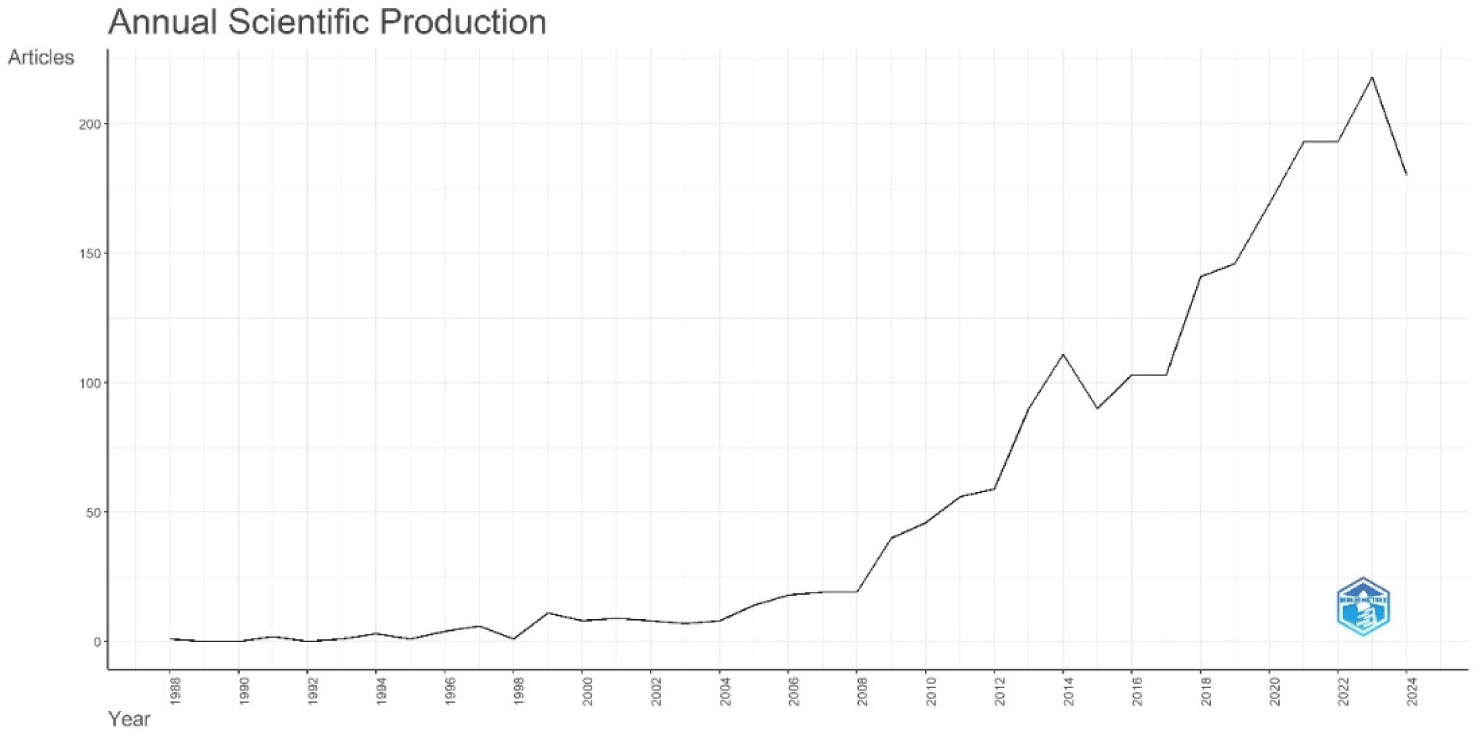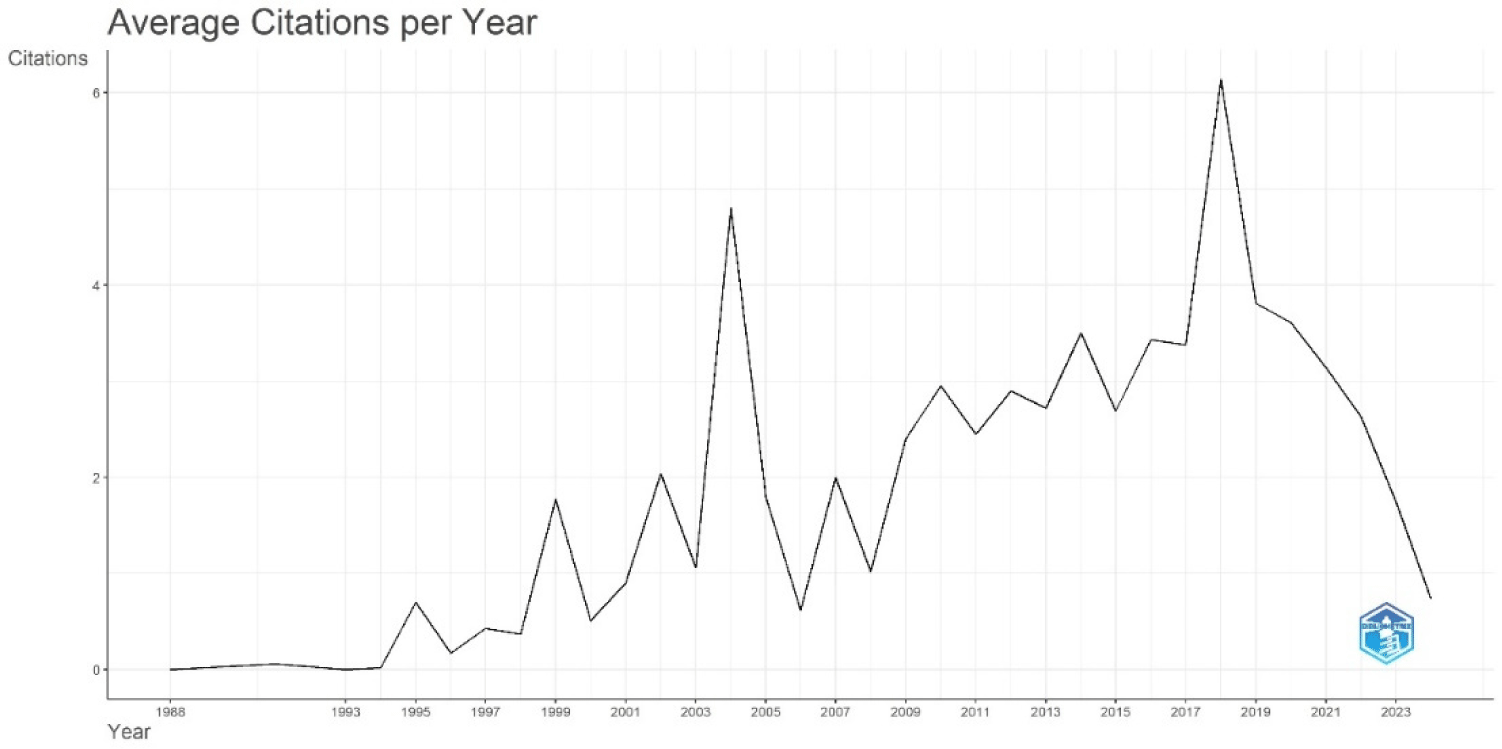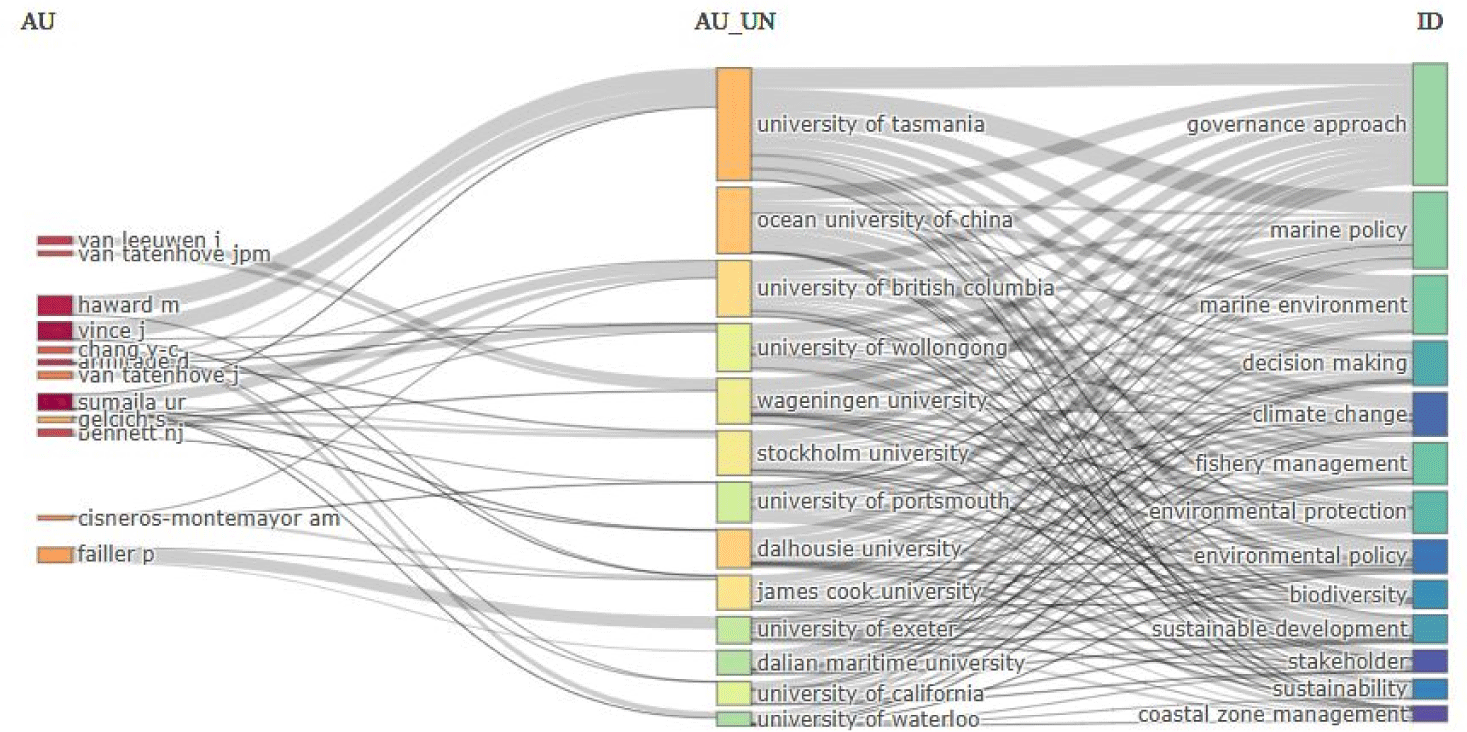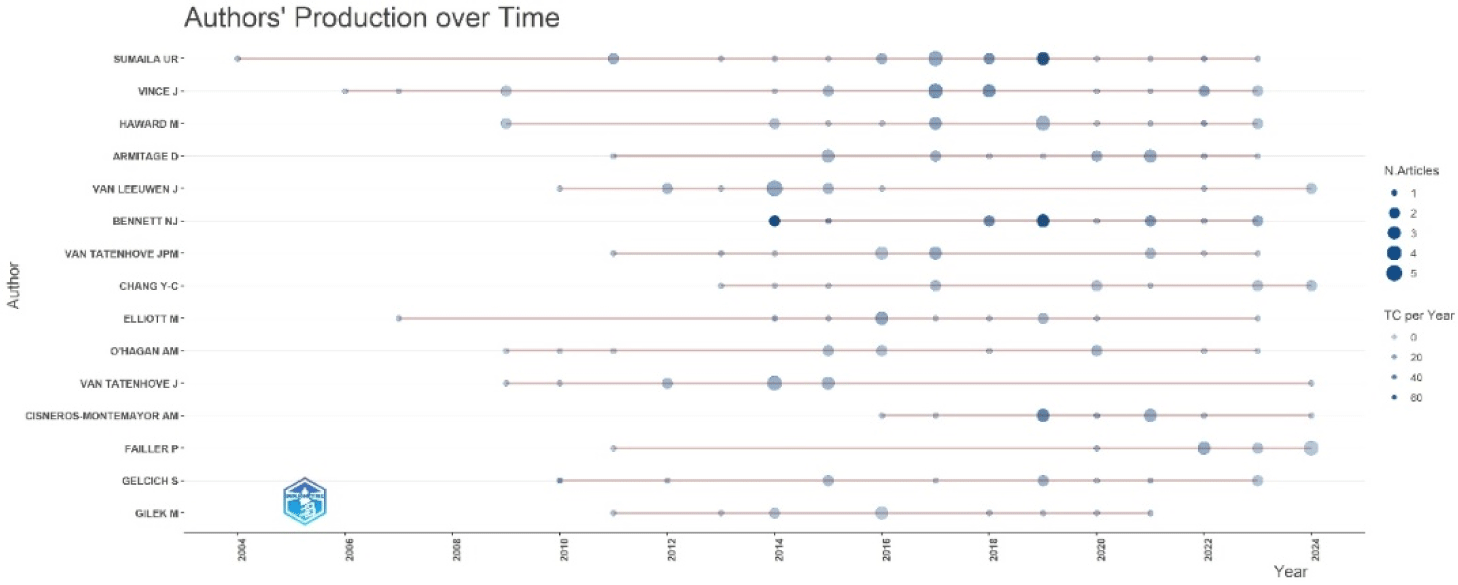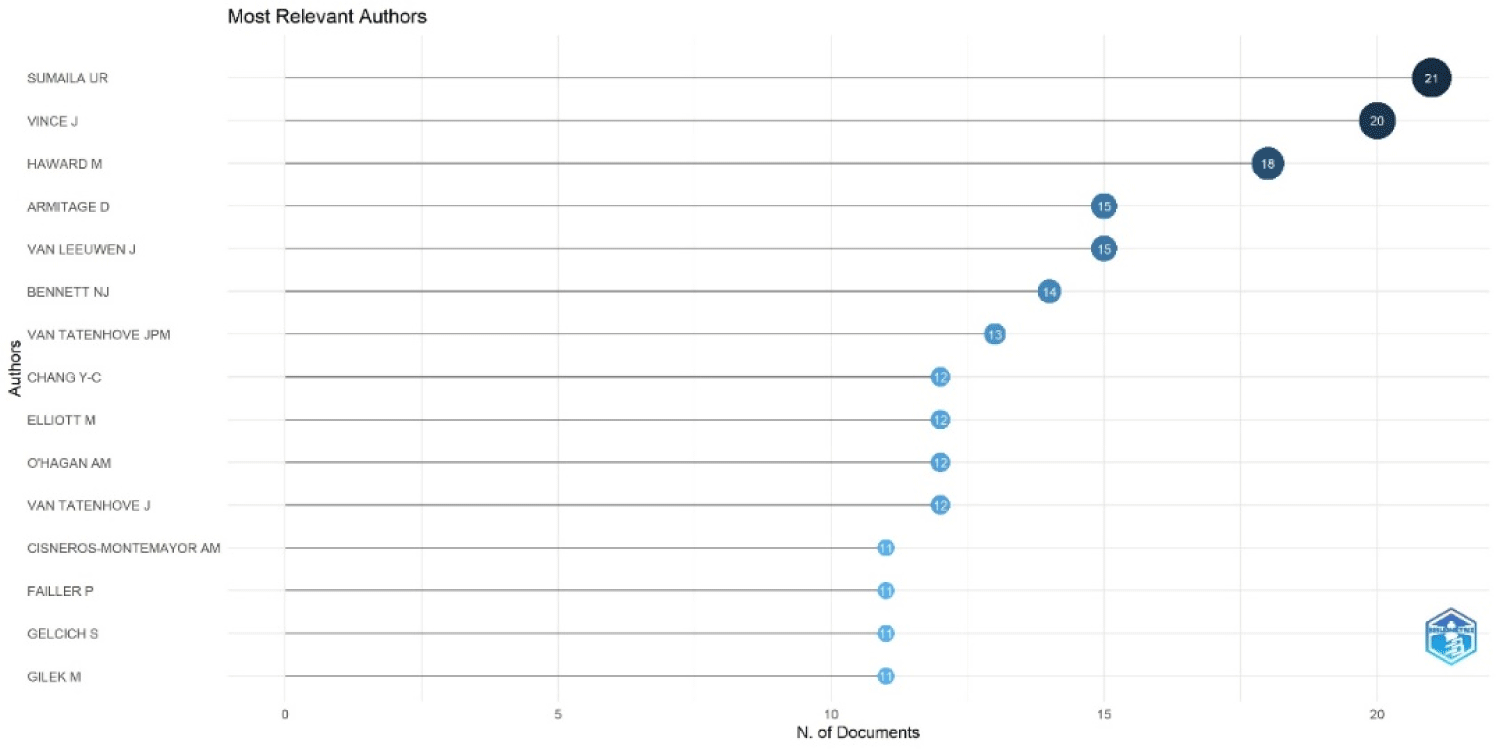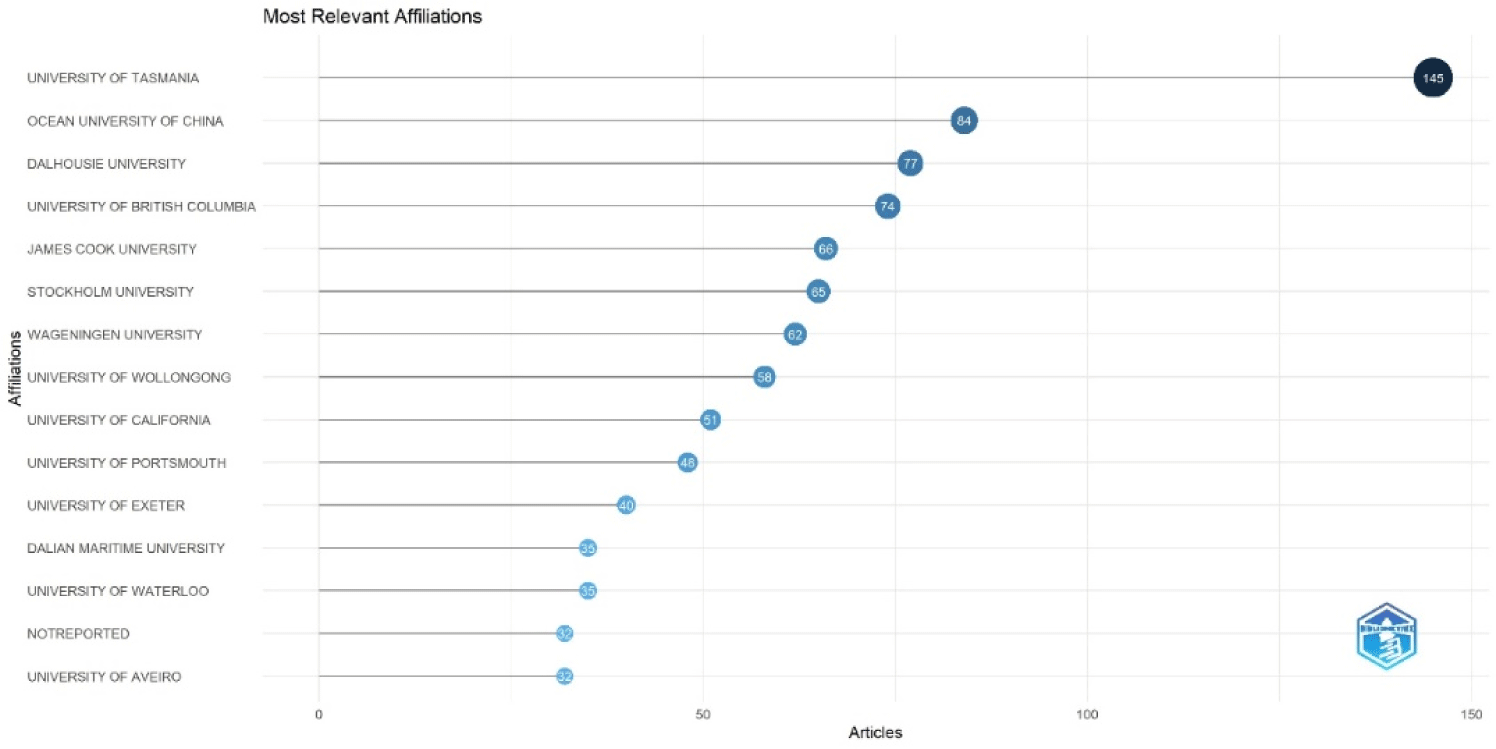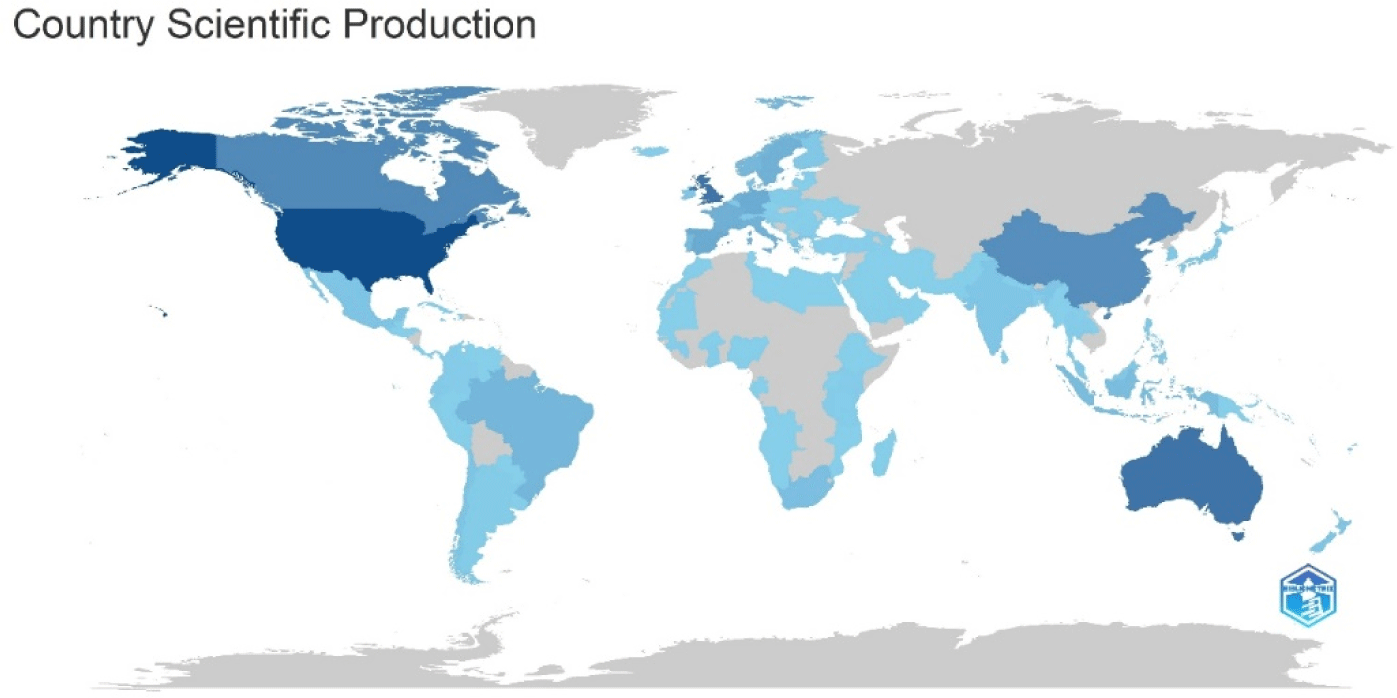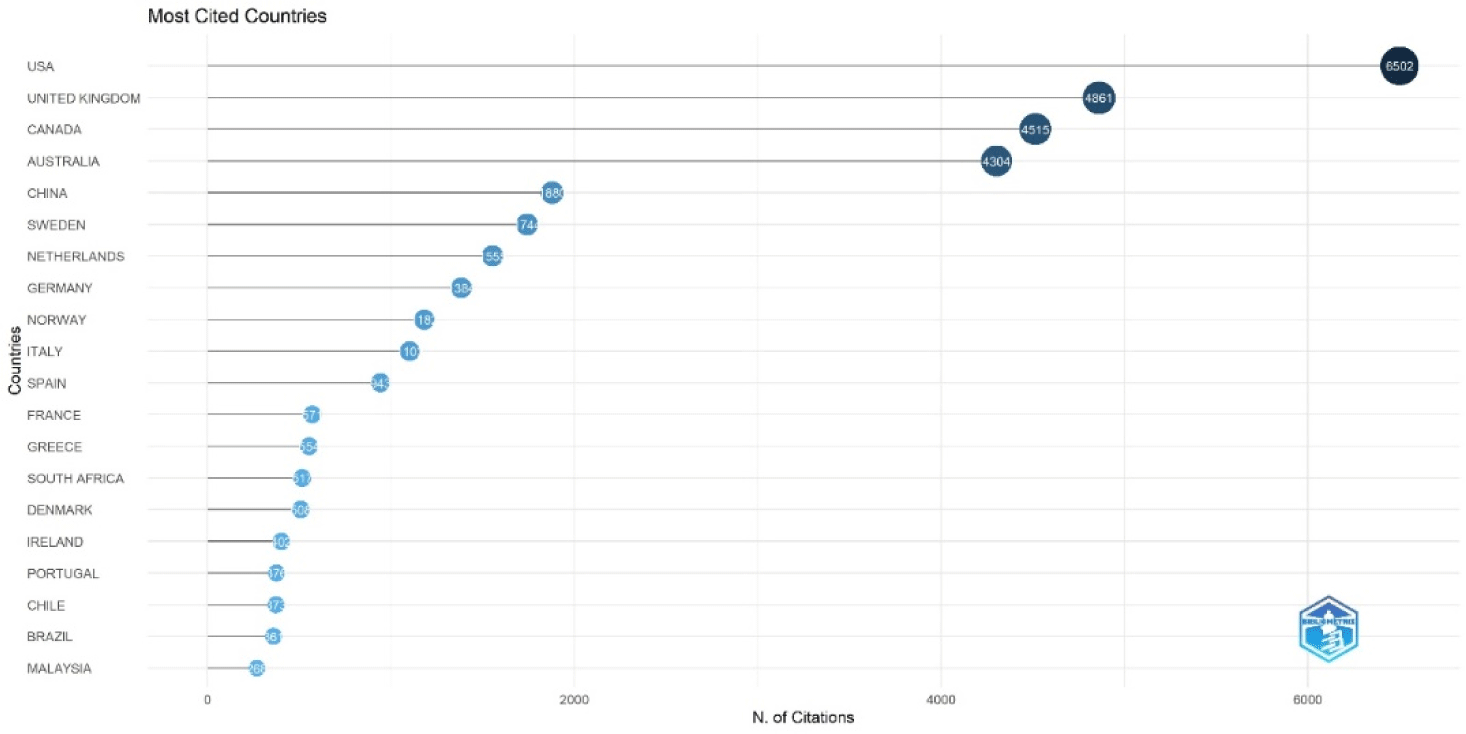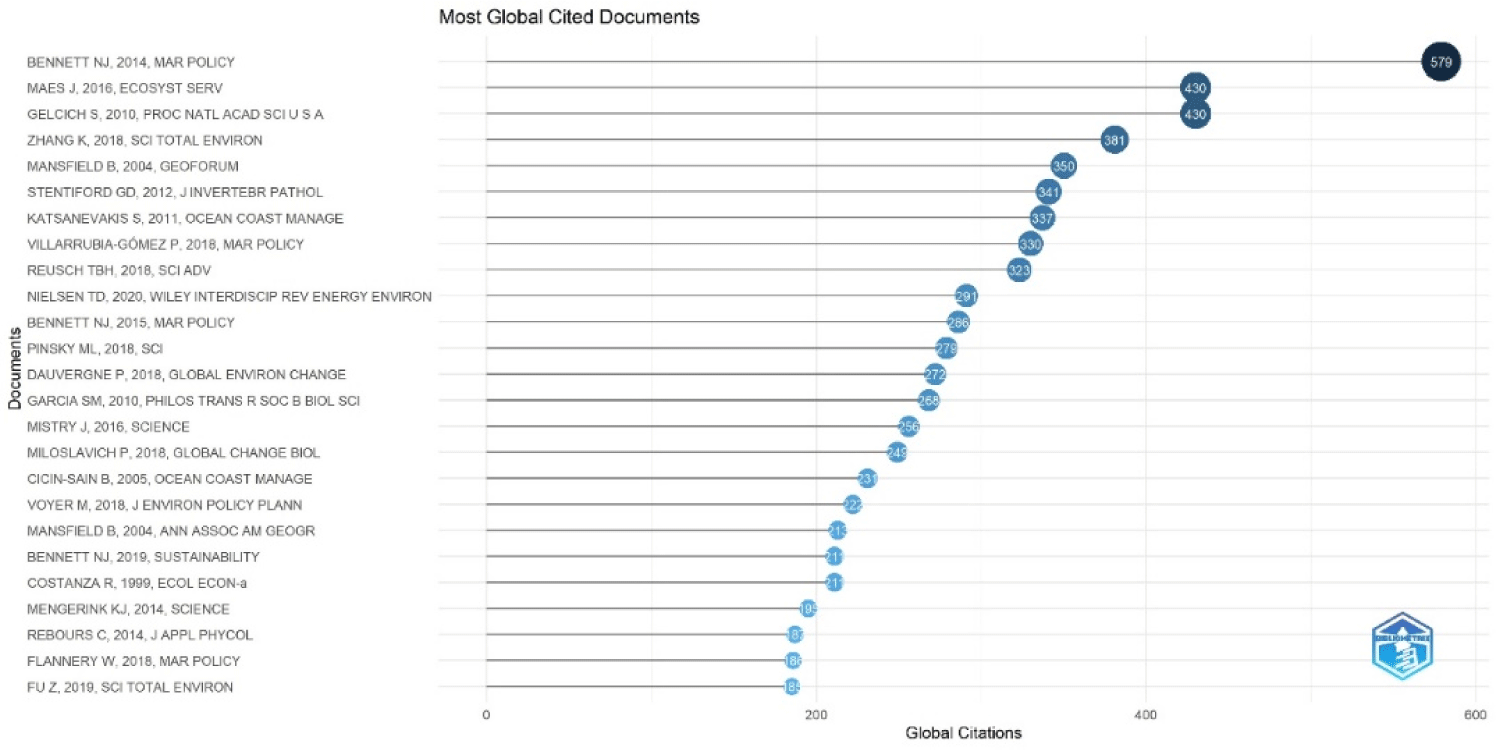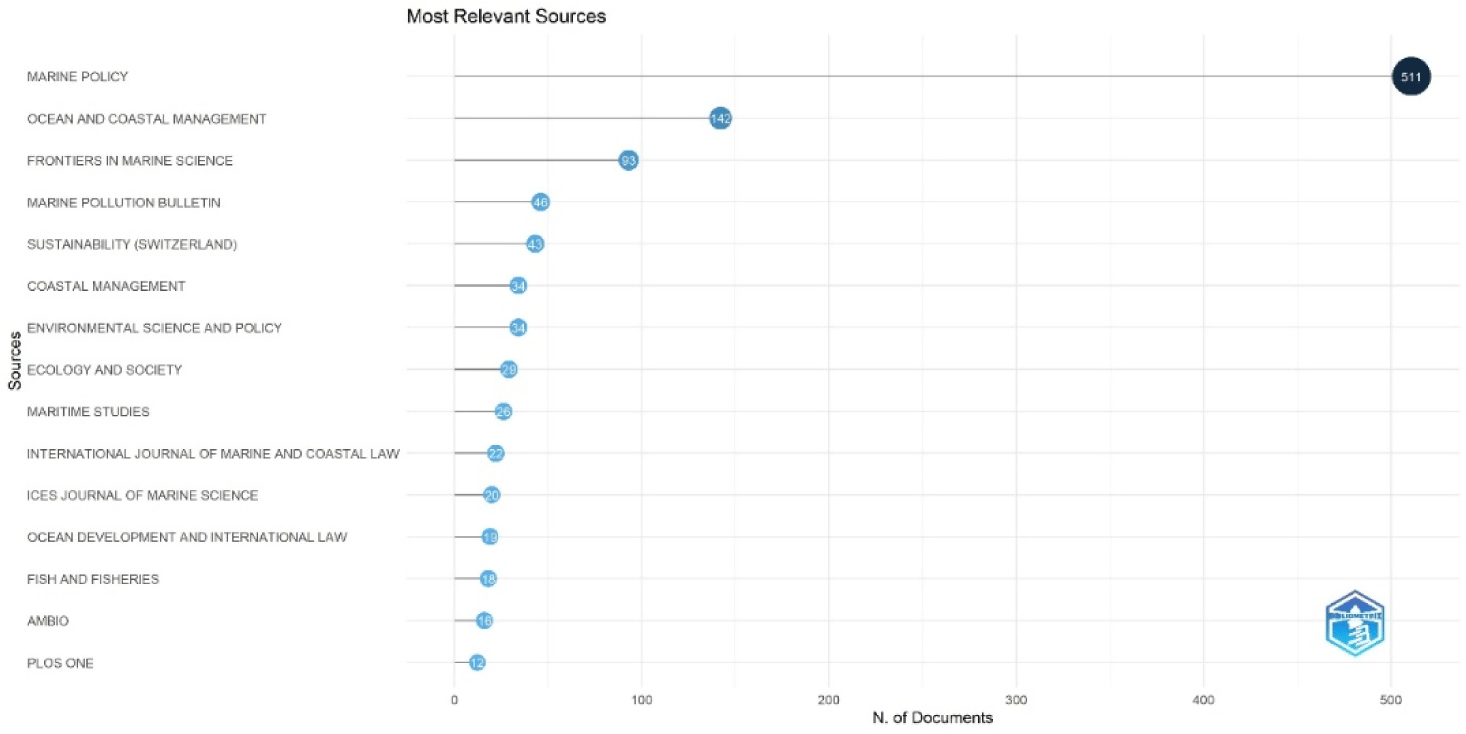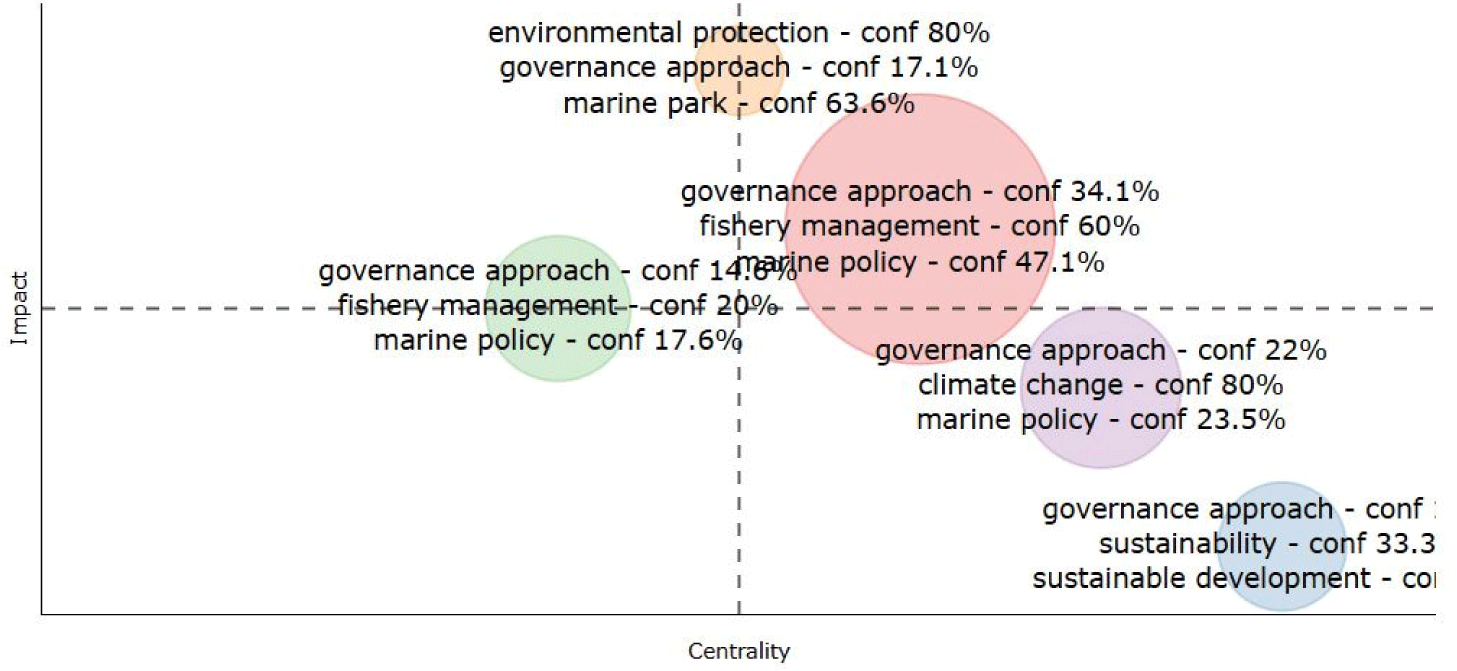1. Introduction
The ocean, covering 70–71 percent of the planetary surface is an important natural asset with a unique natural capital stock (Sumaila et al., 2021, 2023). The ocean is endowed with myriad (a)biotic resources, tangible and intangible goods, and services that sustain the global economy and livelihoods (Cisneros-Montemayor et al., 2019; Matovu et al., 2024b, 2025). Through the tapping of the direct and indirect benefits of the ocean and ocean-based sectors, ocean sustainability targets (socio-cultural, economic, environmental, and institutional governance), could be reaped, as highlighted in several studies (Matovu et al., 2024b). In the economic sustainability domain, the global ocean economy (including sectors, such as fishing) was valued at 1.5 trillion USD in 2010, translating into 2.5 percent of the global gross value added (Matovu et al., 2024c). Today, the annual gross marine product value based on the value of the ocean’s total asset base (including direct output from ocean-based activities, ecosystems, and threshold coastal assets), is estimated at 2.5 trillion USD (Matovu et al., 2024e, 2025; Sumaila et al., 2021). This is projected to increase to 3 trillion USD in 2030 and US$22 trillion by 2050 if equity spaces and sustainable engagement arenas are created (Cisneros-Montemayor et al., 2022; OECD, 2023, 2024).
Additionally, since the ocean is a theatre of coastal activities (including tourism, and recreation), it is critical for the promotion of sustainable livelihood welfare and social aesthetics (Croft et al., 2024; Scott et al., 2024). Most importantly, ocean goods, such as seafood are a vital source of protein to over 3 billion people (FAO, 2024a, 2024b; Matovu et al., 2024b). With the increased focus on the blue economy (BE), the ocean is projected to avail over 30 million jobs across the 13 classes of BE sectors (IRP, 2021; Matovu et al., 2024c, 2024e; Ocean Panel, 2020). In the environmental sustainability domain, the swathes of ocean space ameliorate global ocean circulation patterns and absorb over 30 percent of carbon dioxide emitted from anthropogenic activities (IRP, 2021; OECD, 2023, 2024). By regulating unsustainable carbon dioxide emission fluxes, the ocean is a locus for the attainment of global climate change mitigation targets, and environmental resilience (CBD, 2022; Matovu et al., 2024a). Through the sustainable harnessing of the ocean, progress towards the attainment of sustainable development goals (SDGs), such as SDG 14 (life below water), now and in the future, could be achieved (Fuso Nerini et al., 2024; Matovu and Raimy, 2022; Ota et al., 2022).
The vibrancy with which the potential of the ocean will be tapped hinges on the crafting of sustainable governance initiatives/roadmaps. The recognition of the ocean as a global common has led to the charting of mechanisms and frameworks to jealously safeguard the innumerable benefits the ocean offers (Armitage et al., 2017). In 2012, the BE paradigm/concept was advanced. Through the BE, avenues for the sustainable use of ocean resources, and promotion of socioeconomic justice and equity, led by emerging coastal states, including small island developing states (SIDS) are emphasized (Matovu and Raimy, 2022; Vince et al., 2017). Currently, an overarching and ambitious initiative- the Ocean Decade (2021–2030) has been streamlined. The Ocean Decade is envisioned to unlock transformative ocean governance solutions, including just and equity transformations, and environmental sustainability. Additionally, the high seas treaty has been promulgated as a novel legal/regulatory mechanism to aid sustainability transitions in the Area (Matovu, 2024). This has been spiced up by the adoption of the Convention on Biological Diversity (CBD) plan/agreement (at the Conference of Parties, 2015), synonymously called the Kunming-Montreal Global Biodiversity Framework (GBF) (Maes et al., 2016). The CBD sets forth a global vision of harmonious humannature co-existence by 2050. Among the GBF’s key elements are 4 goals for 2050 and 23 targets for 2030 (CBD, 2022). The need for sustainable ocean futures has further created an urgent need for transformative, reflexive, polycentric, and inclusive governance approaches (Farmery et al., 2021; van Leeuwen et al., 2024). To achieve this grandiose task, several approaches have been proposed to build resilience, and inclusive governance and policies to the increasing environmental-anthropogenic stressors in the coastal and ocean zones. Prominent approaches have included the ecosystem-based management approach, resource nexus approach, nature-based solutions approach, and integrated coastal zone management, among others (Brouwer et al., 2023; Raakjaer et al., 2014).
Although the current governance mechanisms are commendable, multiple ocean crises, unsustainable risk indicators, and threats have continued to unfold (Armitage et al., 2017; Bennett and Dearden, 2014; Bennett et al., 2021, 2022, 2023). Additionally, simmering gaps in ocean policy and governance implementation, and knowledge have persisted, such as the estimation of future stocks and readiness for green or blue transitions in marine shipping and mining (Bleischwitz, 2020; Bleischwitz, Höller, and Kriegl, 2023; IMO, 2023; Jouffray et al., 2020, 2023; Matovu et al., 2024c). In the worst cases, discordant policy and research gaps have escalated in long-established BE sectors, such as marine fishing, mostly in biodiversity-rich but vulnerable tropical regions (Matovu et al., 2024b). Additionally, local elites, and influential, and dominant stake-holders dominate ocean governance, research, and policy directions (Blythe et al., 2021a, 2021b). Amidst this, one may wonder how, when and what has perpetuated these unsustainable indicators! Some studies have succinctly revealed that an untangled web of the intricate politics of ocean governance, limited knowledge or exploration of diverse ocean perspectives, and historical injustices in ocean stewardship account for this unsustainable façade (Blythe et al., 2021a; Farmery et al., 2021; Partelow et al., 2023; Spalding et al., 2023).
This perspective could be true if a critical lens on the trends in ocean policy, and governance stewardship is explored (Armitage et al., 2017; Bennett and Dearden, 2014; IRP, 2021). For instance, although the fervor has been on exploring the ocean (by rich countries), only 26 percent of the ocean is mapped, such as the bathymetry (IRP, 2021; Lubchenco and Haugan, 2023). Limited ocean data-sharing practices have been a norm, thus obliterating knowledge, such as on migratory fish species (FAO, 2024a, 2024b; Matovu and Raimy, 2022). Worst of all, only 16 percent of marine social science research has been conducted (Matovu et al., 2024e; Partelow et al., 2023). These indicators might obliterate the novel ideas invented to drive ocean justice, and sustainable governance transitions (Paterson and Chabay, 2024; Scott et al., 2024). Additionally, in most of the policy literature, what remains to be seen is the unfathomable interest in uncovering intricate dynamics of how these unsustainable research, policy, and governance gaps have mutated. There still seems to be limited literature that explicitly explores the key determinants of just ocean governance and transitions, as emphasized in recent studies (Bennett et al., 2022, 2023; Croft et al., 2024; Matovu, 2024; Matovu et al., 2024e; Paterson and Chabay, 2024; Scott et al., 2024; Stefanoudis et al., 2023; Tafon et al., 2022).
This study contributes to the ocean governance and policy discourse by scything through a comprehensive body of literature to highlight what could be the key lessons and missed points in research and policy over time. This could help create a better understanding on how to build collaborative ocean governance mechanisms. Thus, as the main aim of this study is to understand whether current trends in research and collaboration networks invigorate sustainable ocean futures, the synthesis of literature over time becomes relevant. With the increased emergence of unique literature synthesis tools, such as bibliometric analysis, possibilities of increasing knowledge on progress or regress towards sustainable governance futures can be unlocked. Additionally, through bibliometric analyses, historical injustices, such as in scholarship, research, and policy stewardship can be uncovered (Matovu et al., 2024d; Mim, Kathiravan, and Maniam, 2024). This could be key in guiding just transitions, and inclusive co-creation of fair and equitable ocean governance policies that benefit all (especially through an in-depth analysis of the research trends and nature of research published on global ocean governance and policy). To bring to the fore new insights that could guide sustainable futures in ocean policy and governance, three aims were sought. These included
-
(i) In-depth analysis of the trends in research and performance of authors, countries, and institutions publishing works on ocean governance and policy.
-
(ii) Mapping and synthesizing of current and emerging scientific networks and themes in research and policy concerning ocean governance.
-
(iii) Identifying key leverage points for mitigating historical challenges and charting sustainable futures in ocean research, policy, and governance.
2. Material and Method Used
This study used a systematic literature review method to source literature on ocean governance and policy.
To source literature, the Scopus digital repository was utilized. The search was conducted on 29th September 2024 and the customized search query used was ‘TITLE-ABS-KEY (marine AND governance AND polic*). Using the search query, 2,078 documents were identified, and the documents were downloaded (including their bibliometric information), in a Microsoft Excel CSV file (See link: https://shorturl.at/RfNwF). The search query was customized to (i) include a dearth of evidence-based research articles that integrate marine social and natural science perspectives (historical, and current) (ii) obtain transdisciplinary perspectives on ocean governance and policy and (iii) uncover critical insights and future ocean sustainability perspectives in policy and research since the coining of the BE paradigm in 2012, as emphasized in ocean sustainability studies and literature (Croft et al., 2024; Matovu, 2024; Matovu et al., 2024a, 2024b, 2024c, 2024e; WOA II, 2021).
The bibliometric analysis tool in R software was used to screen and analyze the 2,078 documents. This was done in a phased process, after the installation of a bibliometric analysis tool, called Biblioshiny in R, as guided by Matovu et al. (2024d) and Mim et al. (2024). First, the R software was downloaded, installed, and run on the computer. This was followed by the installation of RStudio. To install the Biblioshiny tool in RStudio, the following procedure was undertaken: (i) clicking on packages, and installing bibliometrix, (ii) inserting the word ‘library (bibliometrix) and run, and (iii) inserting the word ‘Biblioshiny ()’ and enter. On entering, an automated dashboard opened, where the analysis was done. The initially downloaded Excel CSV file was then imported to the opened dashboard for analysis.
As the study aimed at uncovering the trends in research and policy on ocean governance, twelve analyses were conducted. These included (i) research performance analysis (annual scientific production of research, average citations per year, and Three-field plot), (ii) analysis of the most relevant sources and sources production over time, (iii) globally dominant authors and author’s production over time, (iv) most dominant affiliation and affiliation production over time, (v) countries analysis (i.e., corresponding authors’ countries, most cited countries, and countries’ scientific production of research on ocean governance and policy, over time), (vi) documents analysis (i.e., most global cited documents), (vii) words analysis (i.e., dominant keywords used, tree map, and trending topics in research and policy), (viii) social structure and networks (i.e., countries and authors’ collaborations), (ix) intellectual structure and networks (i.e., on co-citation network analysis), (x) conceptual structure (i.e., thematic mapping and evolution), (xi) factorial approach (i.e., word mapping), and (xii) clustering by coupling of key networks in research and policy. The key findings from the analysis are given in the next section.
3. Results
Here, an overview of the bibliometrix of the sourced literature is given. This includes the timespan, document content, and document types (see Table 1). A notable highlight is that from 1988–2024 (36 years), the annual growth rate of research on ocean governance, and policy stands at a respectable 15.52 percent. The number of multiple-authored documents is comparatively higher than that of single-authored papers.
An in-depth analysis of the annual scientific production and citation of research is given in Figure 1. Generally, the annual production of research on ocean governance, and policy has been increasing, especially after 2012. Of concern, however, the mean total citations (TC) per article have been plummeting (Also see Appendices 1 and 2).
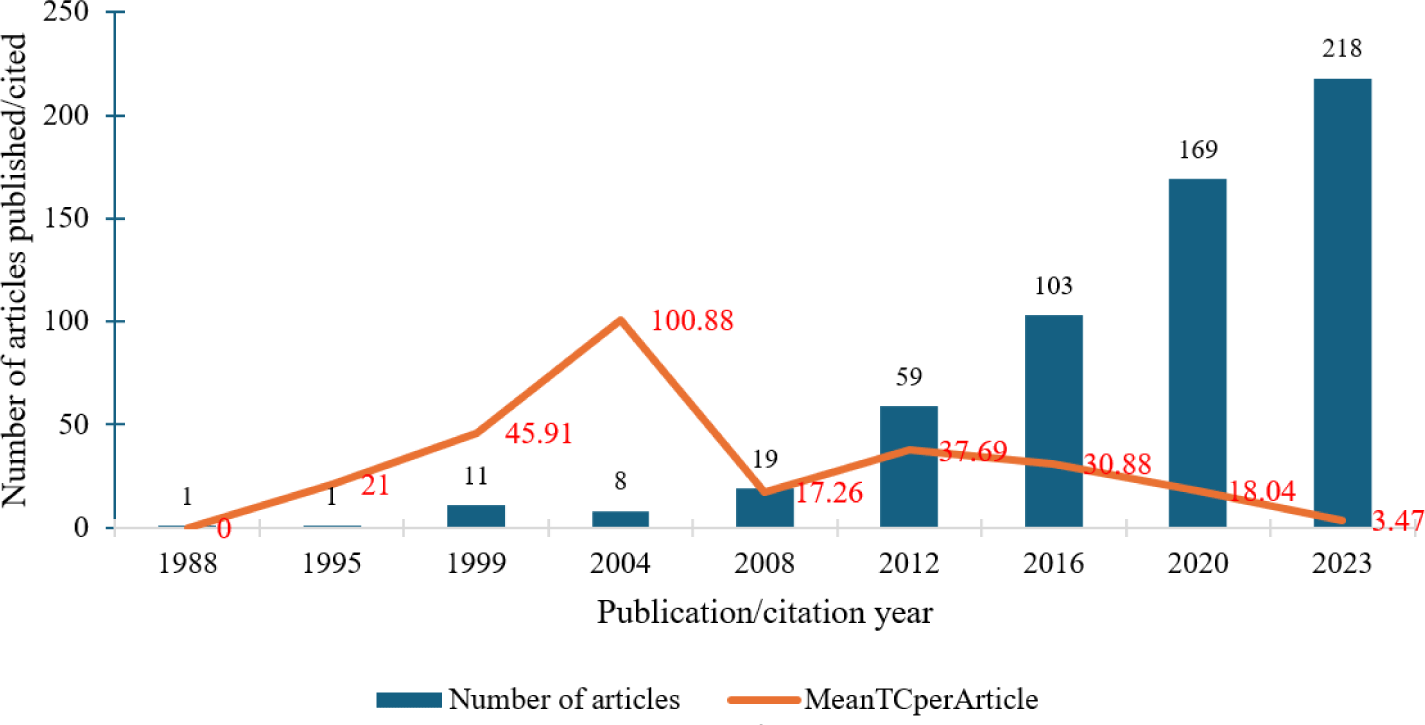
An account of the plummeting citations of research articles could be invigorated by the insights obtained from the three-field plot (Figure 2). An analysis of the 12 authors, 12 keywords, and 12 affiliations revealed three main issues. Dominant authors are from institutions from developed nations, and the keywords being emphasized, such as governance (although commendable), hardly specify inclusive governance mechanisms for sustainable ocean futures, as emphasized in some studies (Partelow et al., 2023; Spalding et al., 2023). The dominance of authors from the global north or similar institutes might also lead to a narrow focus on specific themes, such as marine spatial planning (MSP), and marine protected areas (MPAs). MSP has proved a complex and expensive mechanism in most coastal states, including in the European Union (EU) (van Tatenhove et al., 2017, 2021). A similar trajectory is evident with a three-field plotting based on author keyword plus (Appendix 3). These indicators might translate into limited interest (citation scores/impact) by scholars in vulnerable regions, as they might not augur with the pressing ocean governance and sustainability issues, such as blue equity, and co-governance in the tropics.
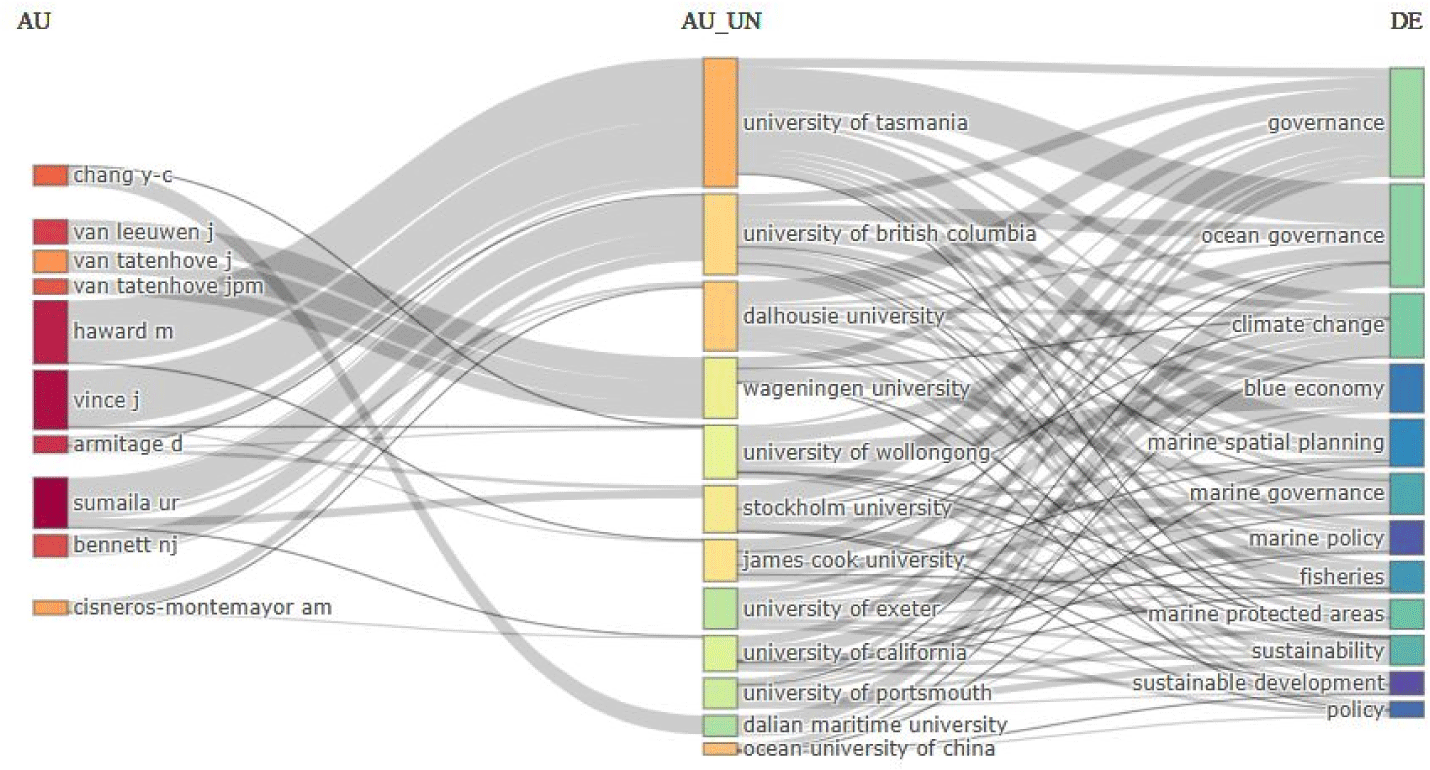
An analysis of the works and perspectives of the global dominant authors can reveal novel directions and insights on whether their works cascade towards sustainability discourses and sustainable futures. In Appendices 4 and 5, the dominant authors based on the number of articles published and TC per year (TCpY) of the published articles are given. In Table 2, the 15 dominant authors (based on the frequency of publications, highest number of TC, and TCpY, over the years are given.
Among the dominant 15 authors, as shown under Table 2, the work of Bennett and Dearden (2014; https://doi.org/10.1016/j.marpol.2013.08.017) published in Marine Policy Journal, has the highest TC and TCpY. This work explains the causation of mal-implementation and limited community support for total conservation measures, such as MPAs in tropical regions. It is recommended that as coastal communities normally view MPAs as a threat to their access rights to marine livelihood resources, collaborative governance mechanisms that aid socio-cultural, economic, and ecological outcomes are urgently needed. Additionally, the works of authors, such as Cisneros-Montemayor et al. (2019) and Sumaila et al. (2021) have highlighted and emphasized critical sustainable governance pathways, such as social equity in the BE and inclusive or adequate financing mechanisms for the vulnerable coastal states.
An overview of the institution’s leading research on ocean governance helps uncover the degree of institutional leadership in research. A review of the 15 dominant institutions in research driving ocean policy and governance is highlighted in Figure 3 (Also see Appendix 6). Here, an unbalanced leadership trend is observed. Leading institutions are either from the global north or developed countries, and no institutions are from emerging/developing countries. (un)surprisingly, this trend is not new, as it has persisted for years. Although these institutions, such as the University of Tasmania have either published or funded critical research on ocean governance especially in the Pacific Ocean SIDS, biases might emerge in reporting or uncovering insights of institutions from vulnerable or less developed coastal states.
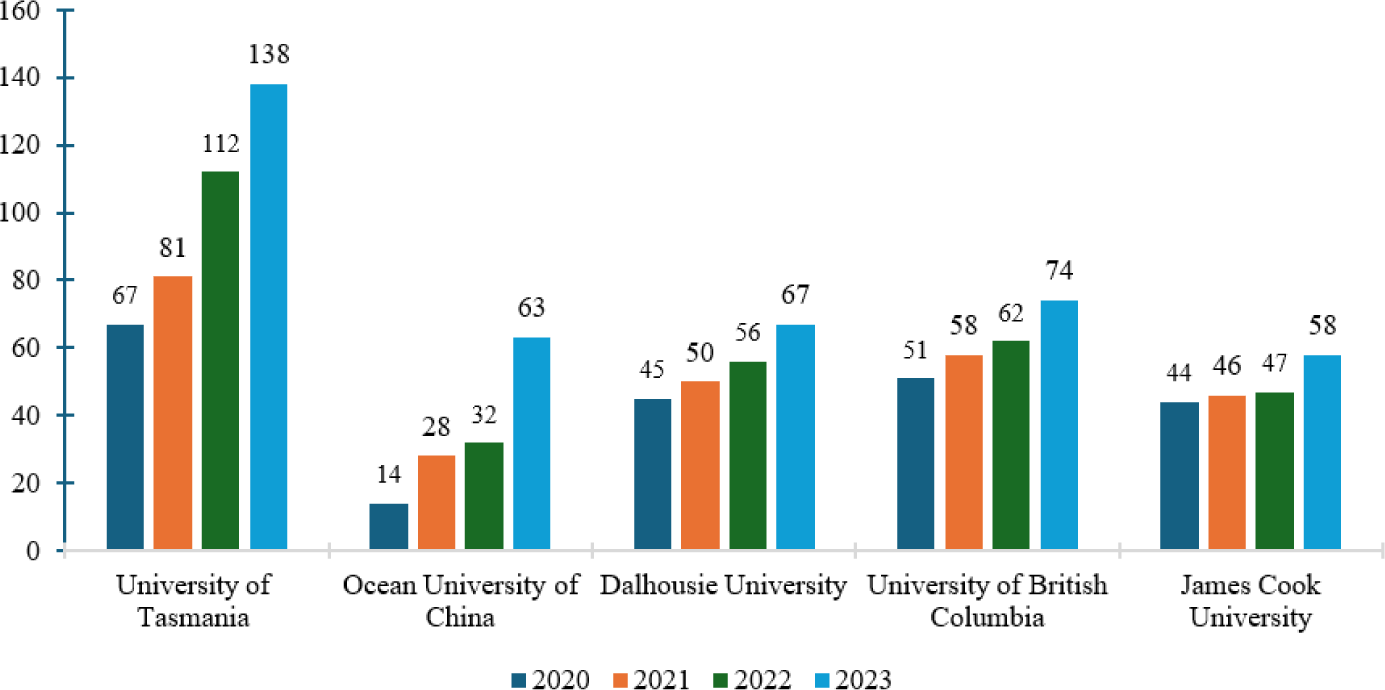
Here, an in-depth analysis of the most cited countries in research, countries’ scientific production of research on ocean governance and policy, and corresponding authors’ countries are indicated.
Table 3 indicates the countries’ scientific production of research on ocean policy and governance. Among the top 20 countries, most publications are from developed or rich countries (See Appendix 7). Only five countries (Marked as “1” in Table 3), categorized as emerging or less developed, have their works prominently published. Most published works are from Australia, European, and North American countries.
A similar trajectory is evident concerning the citation analysis of works by countries. The works published by developed or richer countries have garnered more TCs and average article citations (AACs) compared to works published by developing or emerging countries (Table 4 and Appendix 8). This is irrespective of the publication of similar topics/themes on ocean governance and policy.
In Figure 4, an analysis of the dominant countries in research based on the corresponding authorship is given. Corresponding authorship helps in highlighting the apportionment of research communication (by whom and from where, and the impact it generates). Correspondence on both single-country publications (SCP) and multi-country publications (MCP) is dominated by authors from developed or rich countries. Most countries (including the USA with 134) publish more SCPs than MCPs. This has translated into a relatively high level of impact on their works, as compared to non-corresponding authors’ countries (Appendix 9). The publication of MCPs increases the research impact and visibility of a given country. For instance, with only 31 MCPs of authors from Germany, a higher MCP impact of 50.8 percent has been realized. Only authors and institutions from China have consistently ranked among the highest performing in ocean policy and governance issues.
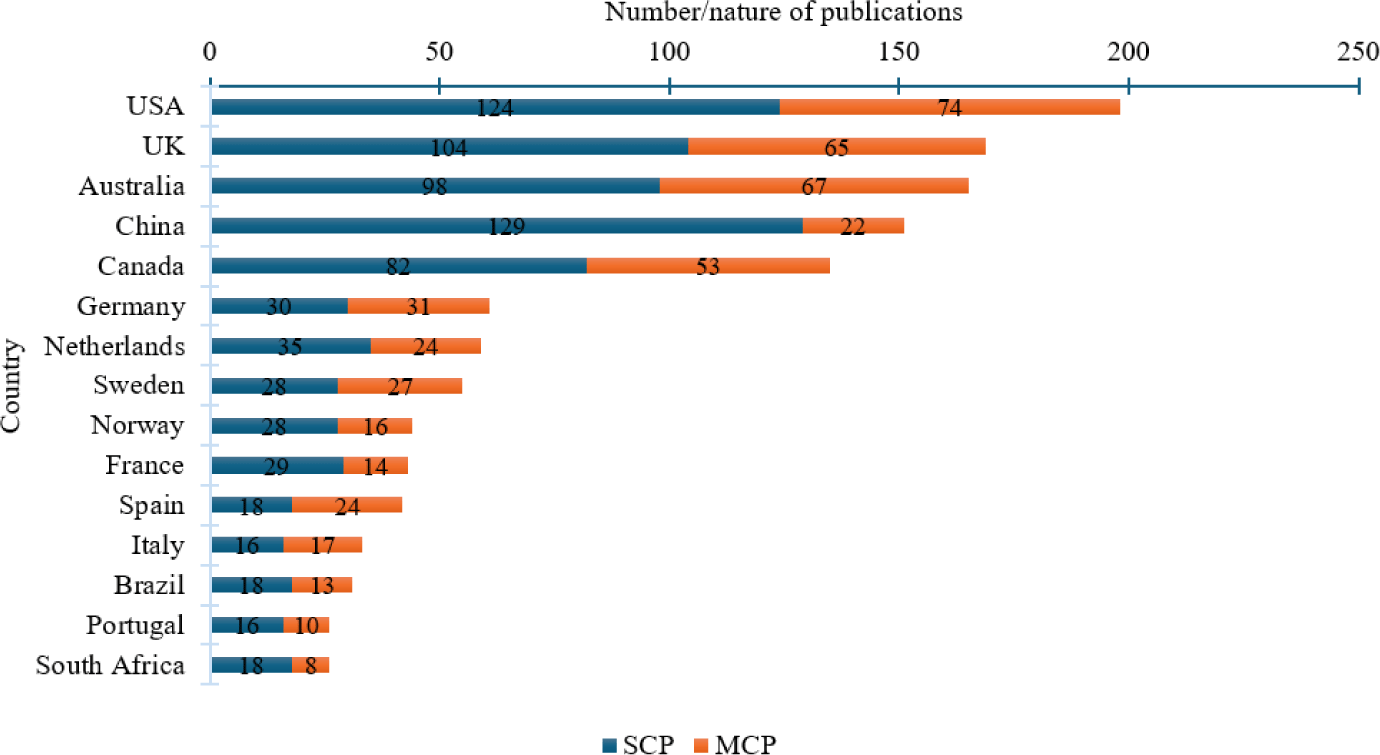
The top 20 global cited documents (including the citation impact of their works) are given under Table 5 (Also see Appendix 10). From the analysis of these documents, critical narratives envisioned to drive ocean sustainability, such as collaborative stakeholder engagements, BE, and ocean equity among others are given. For instance, the work of Dauvergne (2018) succinctly highlights the impediments to the governance of ocean pollution, including (i) globalization of the plastic industry, (ii) fragmented and complex policies on marine plastic pollution, and (iii) resistance to self-regulating or coherent reforms/regulations by key industry stakeholders. Other studies have explained the socioecological ramifications of unsustainable ocean management practices, and recommended several BE and sustainability mechanisms (Matovu et al., 2024b, 2025; Spalding et al., 2023). This calls for the enactment of a stronger and more comprehensive global marine plastics treaty and collaborative governance mechanisms for ocean sustainability outcomes.
| Paper and publication year | Journal | DOI | TC | TC/year | Normalized TC |
|---|---|---|---|---|---|
| Bennett NJ, 2014 | Marine Policy | https://doi.org/10.1016/j.marpol.2013.08.017 | 579 | 52.64 | 15.03 |
| Maes J, 2016 | Ecosystem Services | https://doi.org/10.1016/j.ecoser.2015.10.023 | 430 | 47.78 | 13.92 |
| Gelcich S, 2010 | Proceedings of the National Academy of Sciences | https://doi.org/10.1073/pnas.1012021107 | 430 | 28.67 | 9.71 |
| Zhang K, 2018 | Science of the Total Environment | https://doi.org/10.1016/j.scitotenv.2018.02.300 | 381 | 54.43 | 8.86 |
| Mansfield B, 2004 | Geoforum | https://doi.org/10.1016/j.geoforum.2003.05.002 | 350 | 16.67 | 3.47 |
| Stentiford GD, 2012 | Journal of Invertebrate Pathology | https://doi.org/10.1016/j.jip.2012.03.013 | 341 | 26.23 | 9.05 |
| Katsanevakis S, 2011 | Ocean & Coastal Management | https://doi.org/10.1016/j.ocecoaman.2011.09.002 | 337 | 24.07 | 9.82 |
| Villarrubia-Gómez P, 2018 | Marine Policy | https://doi.org/10.1016/j.marpol.2017.11.035 | 330 | 47.14 | 7.68 |
| Reusch TBH, 2018 | Science Advances | https://doi.org/10.1126/sciadv.aar8195 | 323 | 46.14 | 7.51 |
| Nielsen TD, 2020 | Wiley Interdisciplinary Reviews in Energy & Environment | https://doi.org/10.1002/wene.360 | 291 | 58.20 | 16.13 |
| Bennett NJ, 2015 | Marine Policy | https://doi.org/10.1016/j.marpol.2015.03.026 | 286 | 28.60 | 10.62 |
| Pinsky ML, 2018 | Science | https://doi.org/10.1126/science.aat2360 | 279 | 39.86 | 6.49 |
| Dauvergne P, 2018 | Global Environmental Change | https://doi.org/10.1016/j.gloenvcha.2018.05.002 | 272 | 38.86 | 6.33 |
| Garcia SM, 2010 | Philosophical Transactions of the Royal Society B: Biological Sciences | https://doi.org/10.1098/rstb.2010.0171 | 268 | 17.87 | 6.05 |
| Mistry J, 2016 | Science | https://doi.org/10.1126/science.aaf1160 | 256 | 28.44 | 8.29 |
| Miloslavich P, 2018 | Global Change Biology | https://doi.org/10.1111/gcb.14108 | 249 | 35.57 | 5.79 |
| Cicin-Sain B, 2005 | Ocean & Coastal Management | https://doi.org/10.1016/j.ocecoaman.2006.01.001 | 231 | 11.55 | 6.47 |
| Voyer M, 2018 | Journal of Environment Policy & Planning | https://doi.org/10.1080/1523908X.2018.1473153 | 222 | 31.71 | 5.16 |
| Mansfield B, 2004 | Annals of the Association of American Geographers | https://doi.org/10.1111/j.1467-8306.2004.00414.x | 213 | 10.14 | 2.11 |
| Bennett NJ, 2019 | Sustainability | https://doi.org/10.3390/su11143881 | 211 | 35.17 | 9.24 |
The need for transformational changes in ocean governance, especially in tropical regions scavenged by human-environmental shocks, such as pollution, overfishing, and climate change, is further emphasized by studies conducted by (Gelcich et al., 2010; Maes et al., 2016). The work of Pinsky et al. (2018) further dissects into the critical issues related to migratory species, such as fish. It is argued that marine living organisms, such as fish have shifted/migrated at an average rate of 70 kilometers per decade. With the increasing changes in ocean circulation patterns and human activity, these migrations are projected to spiral (Miloslavich et al., 2018). This creates a need for collaborative local, national, regional, and international governance pathways to avert possible conflicts regarding migratory marine living resources ownership and access (Miloslavich et al., 2018; Pinsky et al., 2018).
Additionally, interest in publishing novel ocean governance and policy issues, notably by top journals in ocean research, such as Marine Policy, has increased since 2012 (Figure 5). For instance, among the top five journals publishing research on ocean policy and governance, Marine Policy and Ocean & Coastal Management rank first and second. A review of the website of the Marine Policy journal (Marine Policy | Journal | ScienceDirect.com by Elsevier), gives an account of this. For over two and a half decades, the journal has published top-notch research on ocean policy, and governance issues, across geographies. This partly implies that the Marine Policy Journal is a respectable journal in this discourse.
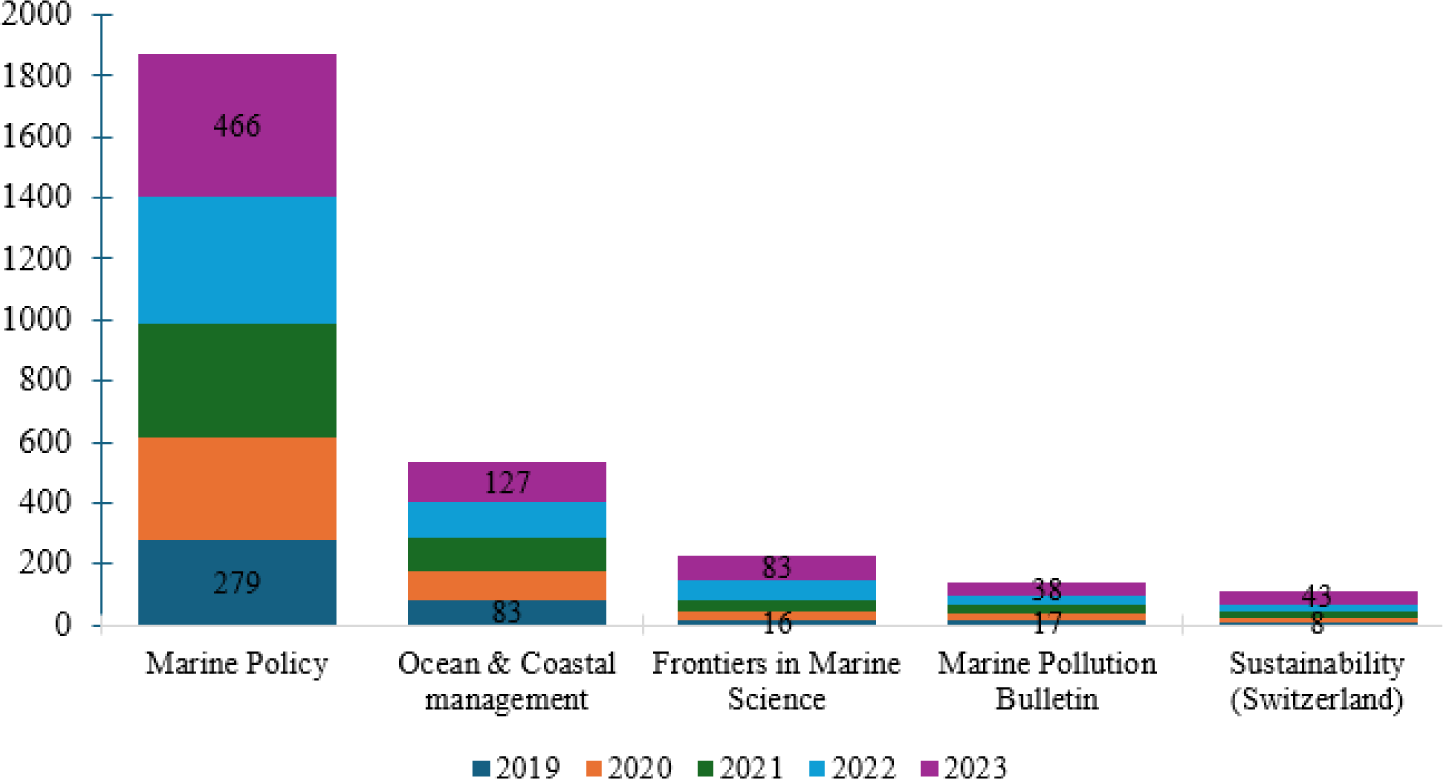
Authors publishing in these journals have garnered high impact (in terms of citations, collaborations, and funding for early career researchers). For instance, the most cited journal of Bennett and Dearden (2014), was published in the Marine Policy Journal (See Table 5).
As part of scientific mapping and network analysis, word analysis unravels critical keywords and trending topics in research (Mim et al., 2024). In this study, three components are analyzed: (i) dominant keywords used, (ii) tree mapping, and (iii) trending topics in research and policy.
In Figure 6, a keyword plus analysis of the 100 dominant keywords used by authors and in documents on ocean governance and policy is given. A critical overview of the keywords reveals two critical issues: (i) there is an emphasis on ocean governance and marine policies, but (ii) there seems to be a lack of specific focus on how this could be done. For instance, keywords, such as ‘protected area’ and ‘conservation management’, are increasingly becoming discordant conduits for sustainable and inclusive ocean governance. This has been emphasized in several prominent studies on ocean equity, governance, and policy (Bennett and Dearden, 2014; Bennett et al., 2021; Cisneros-Montemayor et al., 2019, 2022; Croft et al., 2024).
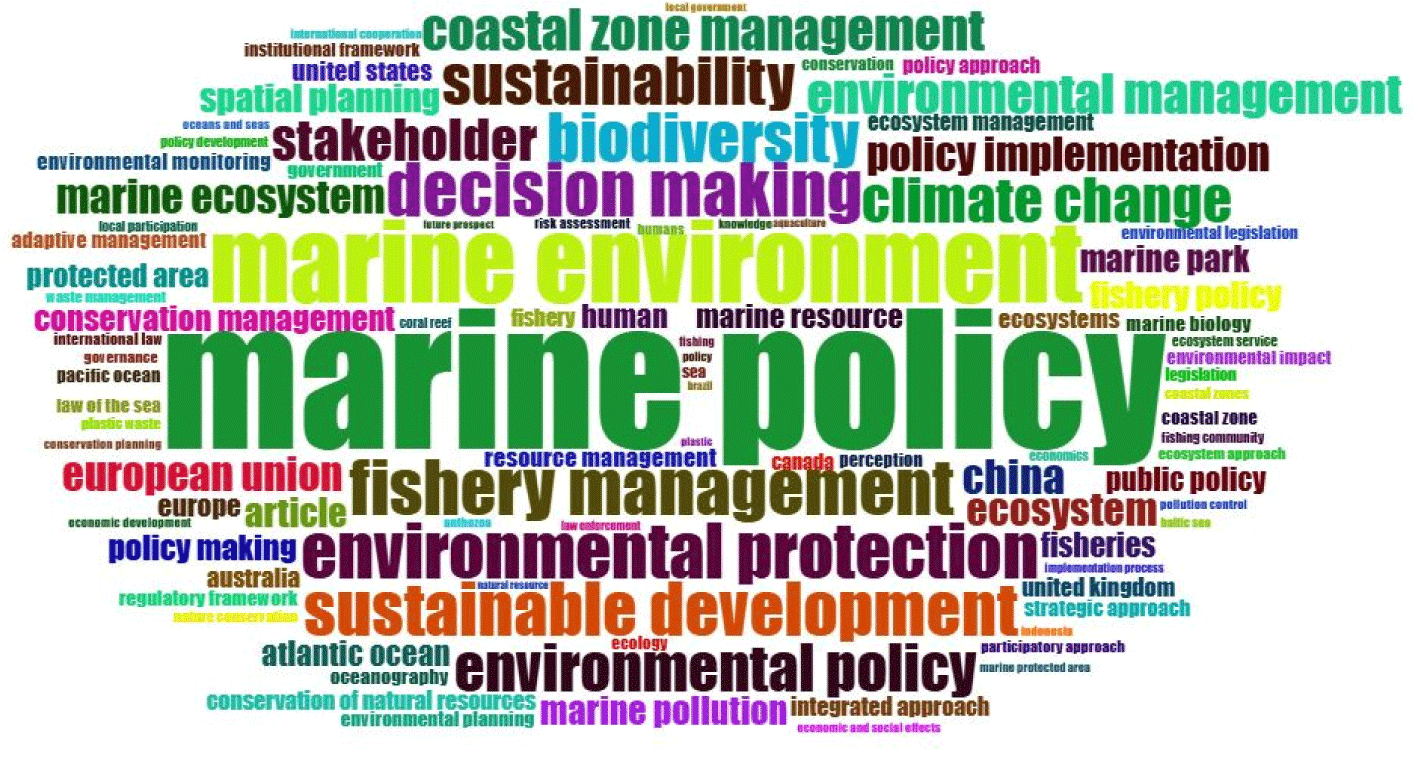
The limited focus on sustainable and inclusive ocean governance mechanisms is explicitly revealed in the tree map (Figure 7). For instance, although authors, institutions, documents, and sources emphasize the need for ocean governance, only 6 percent of the keywords emphasize this. Only 2 percent of the keywords by authors emphasize the importance of crucial sectors that drive ocean equity and livelihoods, such as small-scale fisheries. Additionally, 1 percent of documents/research emphasize the need for knowledge on high seas, coastal community participation, or stakeholder engagements. This might create bleak futures for co-governance and identification of sustainable ocean governance transitions, and mechanisms, as emphasized in recent studies (Croft et al., 2024; Matovu, 2024; Matovu et al., 2024a, 2024e; Scott et al., 2024).
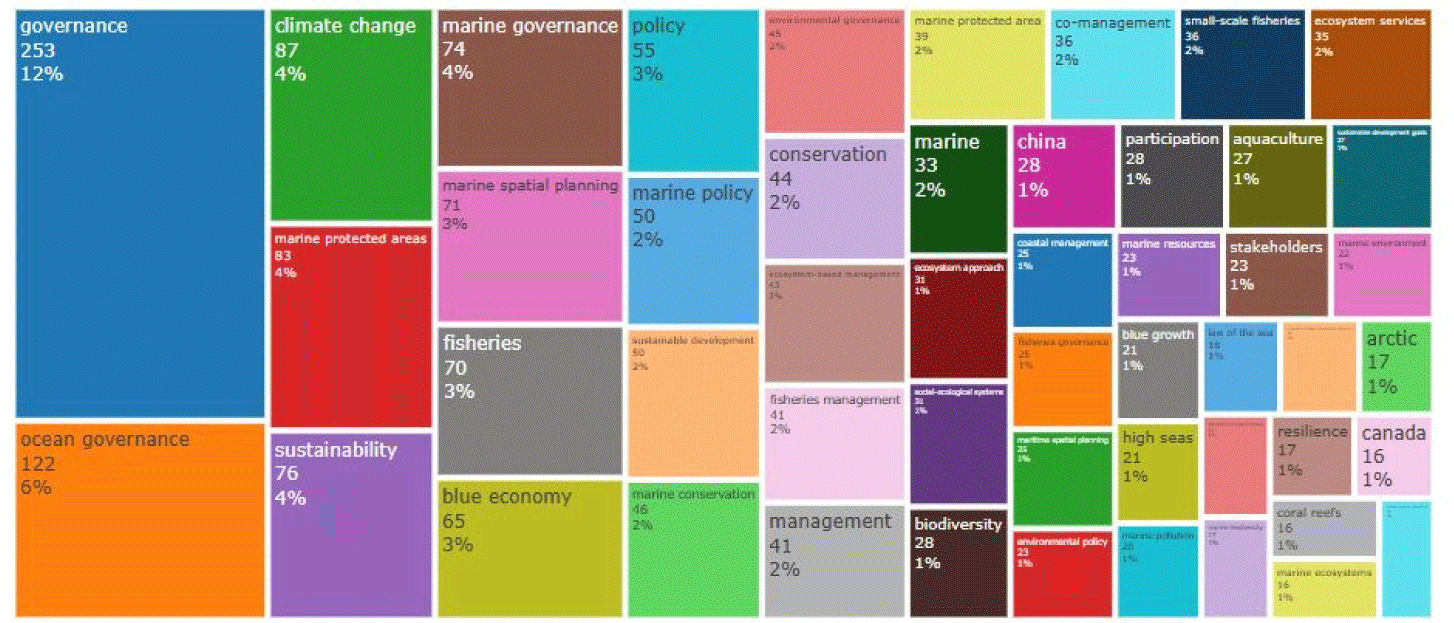
A more worrisome trend is revealed with the keyword analysis of the trending topics in ocean governance and policy research from 2012 to 2024 (Figure 8). For instance, critical themes envisioned to drive ocean equity, policy, and sustainability, such as environmental justice are a recent addition in scholarship. Unfortunately, the frequency of such critical themes, including BE, is still low (with a frequency score of less than 50).
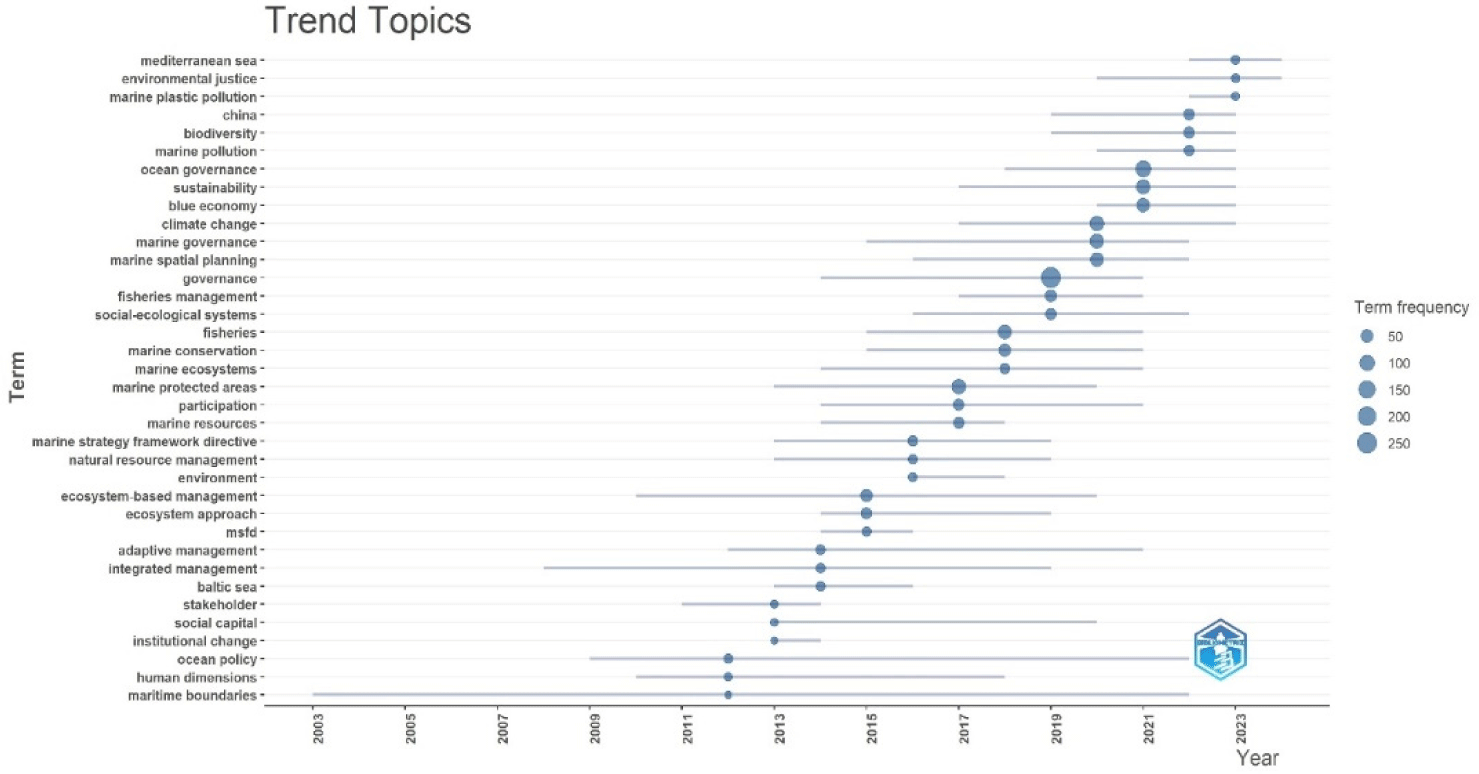
Social network analysis denoted the dynamics of authors’ and countries’ collaborations over time (Matovu et al., 2024d; Mim et al., 2024). In other words, it shows how or which countries/authors collaborate with whom. From a countries’ collaboration map, there is evidence that collaborations are dominant among countries with the same level of development. Most developed or rich countries collaborate amongst themselves. For instance, there are more collaborations between the USA and countries, such as Australia, and Japan. Few collaborations exist between developed and developing countries (Figure 9).
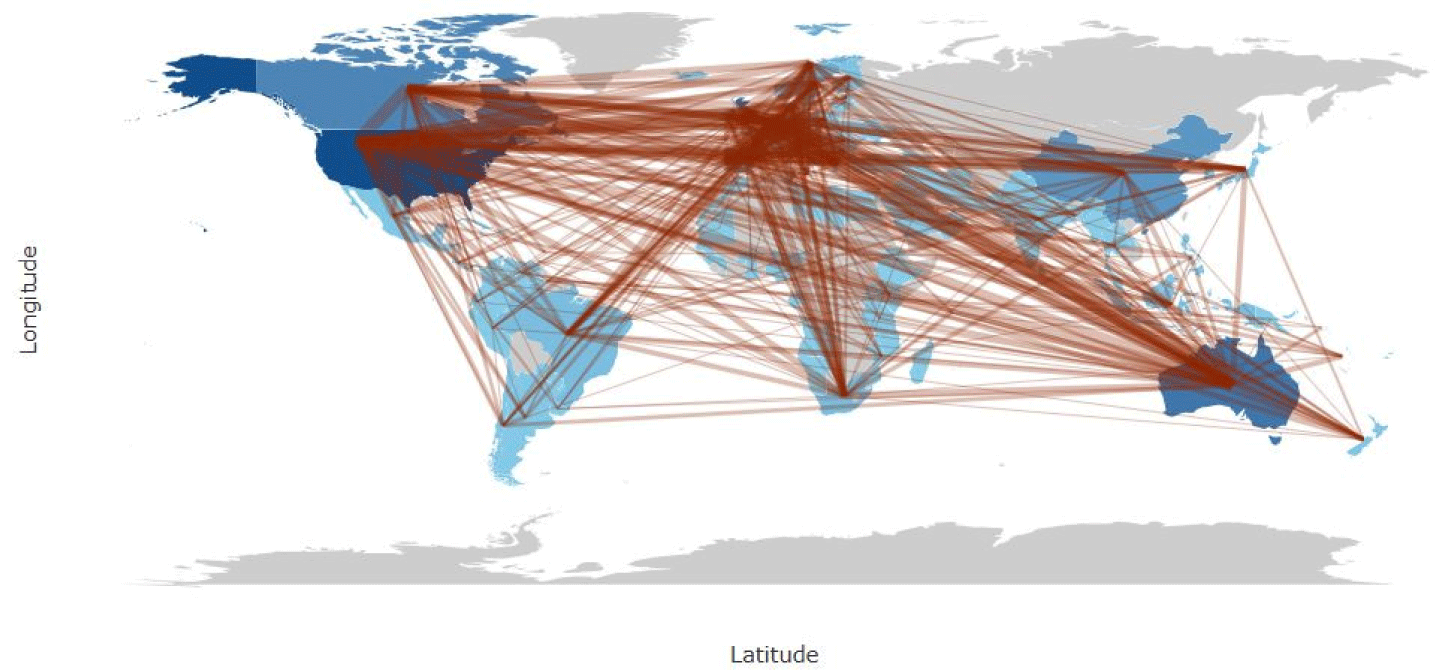
A similar trend is revealed concerning authors’ collaborations. There seems to be a preference for collaborations among authors from the same regions (developed), global prominence, institutions, research fields, or countries. As highlighted in the density map (Figure 10), prominent authors, such as Van Leeuwen J and Van Tatenhove J, have mainly concentrated their research and collaborations in Europe or on issues affecting ocean governance in the European context. This is revealed in their recent work on ‘Theorizing reflexivity and transformative change in marine governance’ (https://doi.org/10.1080/1523908X.2024.2337706). Although a commendable scholarly input is revealed concerning the limited comprehension of transformative ocean governance approaches, the limited collaboration with scholars from developing/emerging countries might lead to the missing out on critical human-centric and community transformative governance perspectives from vulnerable tropical communities.
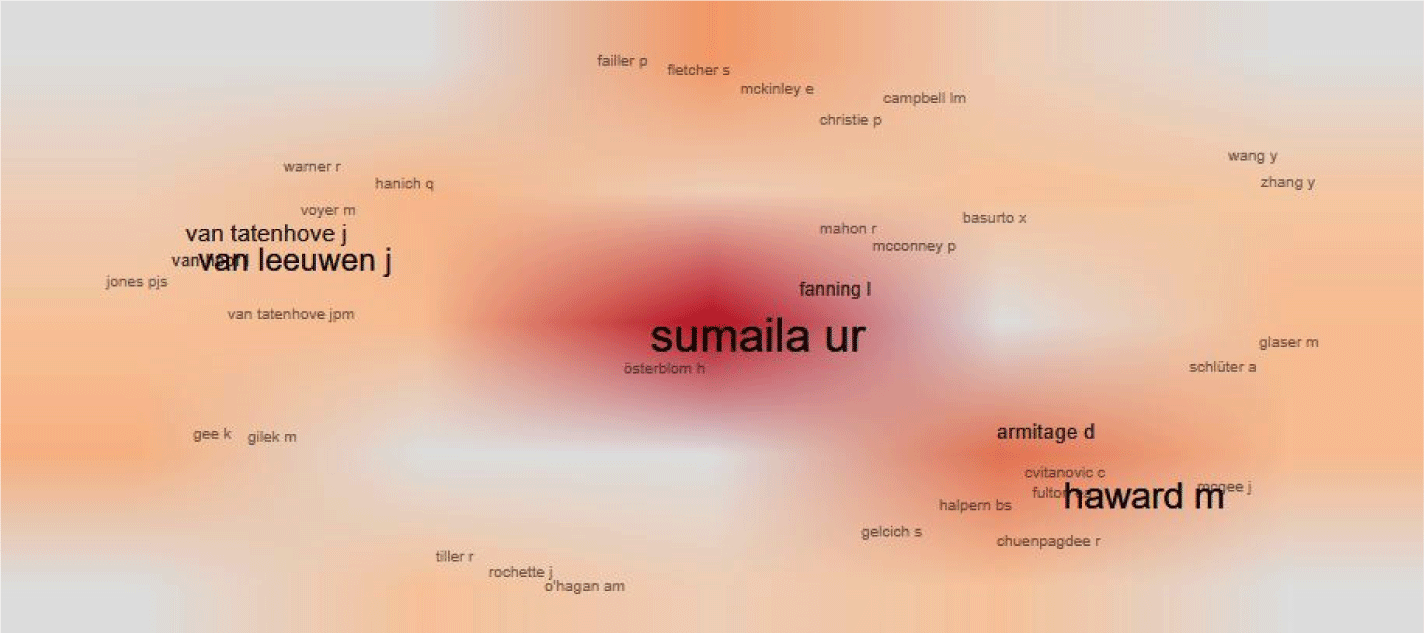
Here, a co-citation network analysis of the works of authors is done. As indicated in Figure 11, most authors cite the works of those authors within each field. This regurgitates the inclusion of diverse perspectives in research. For instance, most of the prominent works of Vince J, have focused on ocean governance in the scope of MSP or MPAs, such as in Australia and the South Pacific Ocean (Vince et al., 2015, 2017). This could partly explain the cobweb of networks with authors, such as Douvere F and Ehler C, who have extensively published on MPA and MSP. For instance, a recent article by Ehler (2021), gives a chronology of MSP, implementation challenges, and possible strategies for inclusive MSP by 2030.
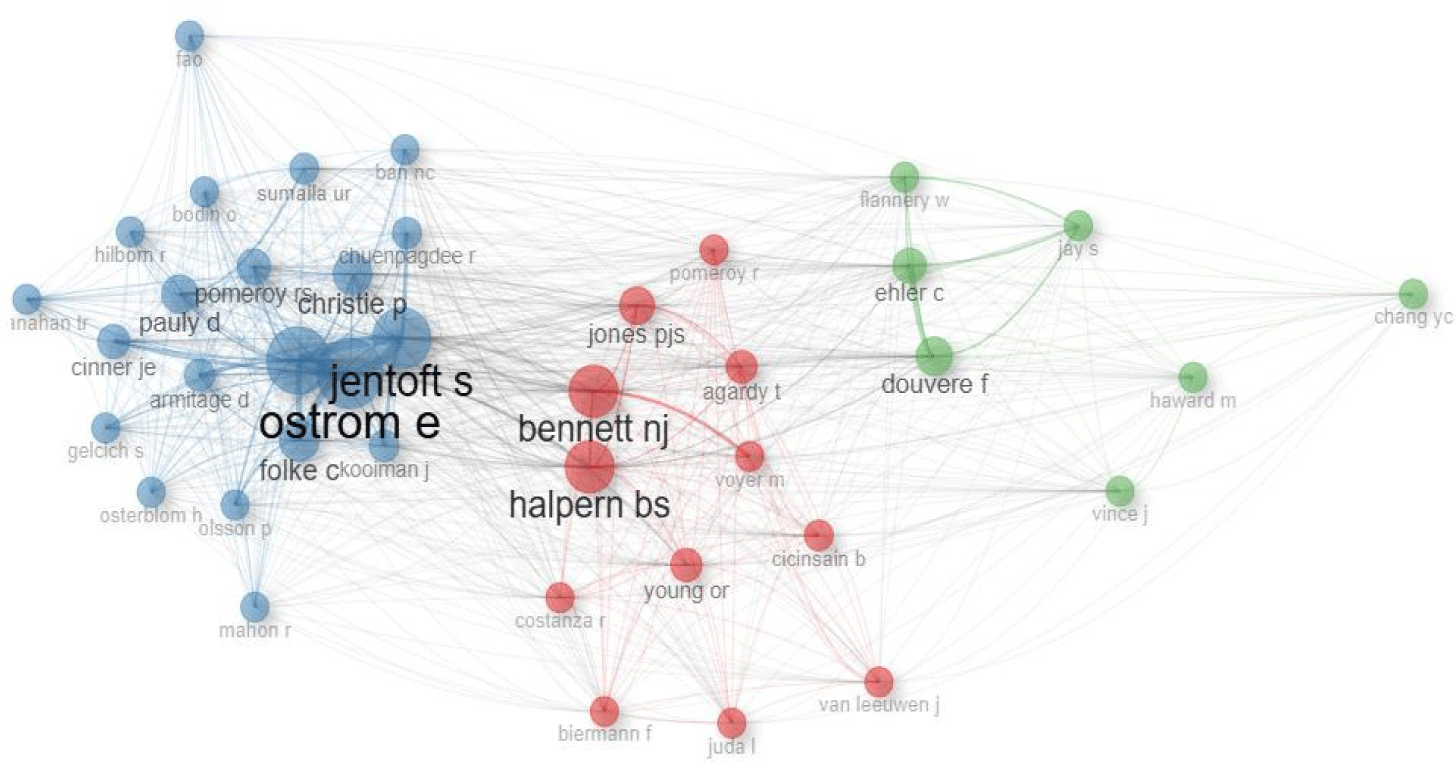
Using a network approach to analyze keywords used by authors researching ocean policy and governance, two components of analysis were identified: (i) thematic mapping and (ii) thematic evolution. Thematic mapping underscores the degree of relevance and development of themes in each field (Mim et al., 2024). In Figure 12, the thematic mapping of the dominant 50 keywords used by authors in the research is indicated. Key themes emphasized in ocean sustainability research and policy, such as co-management, socio-ecological systems, ocean governance, and high seas are still either basic or motor themes (low relevance degree). Worse still, inclusive perspectives, such as blue carbon, MSP, and blue growth are still emerging or declining themes (Appendix 11).
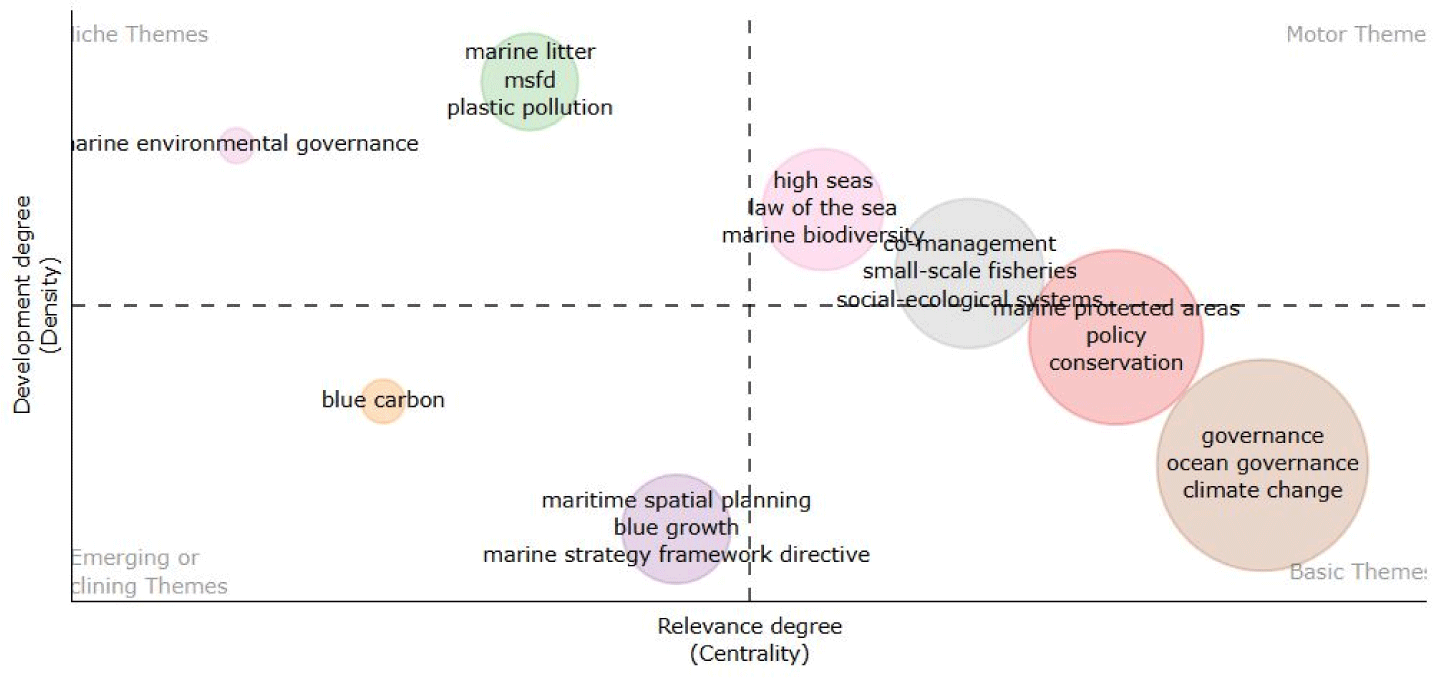
The low level of prominence of critical themes emphasized in ocean research, policy, and governance is highlighted by clustering using coupling, of the keywords plus used in articles, and by authors (Appendix 12). Most often, the perspectives and narratives of the impact of research have been shifting towards hard laws/regulations or strict ocean governance mechanisms, such as environmental protection (80 percent), and marine parks (63.6 percent).
The declining degree of relevance of historically prominent/dominant themes could be well-explained by the analysis of keywords over time. A thematic evolution of prominent themes reveals that prominent governance and ocean policy themes have been shifting (Figure 13). Irrespective of the changing themes, critical safety nets for ocean governance, and policy, such as the ocean regime as guided by the United Nations Convention on the Law of the Sea (UNCLOS), have gained less interest among researchers.
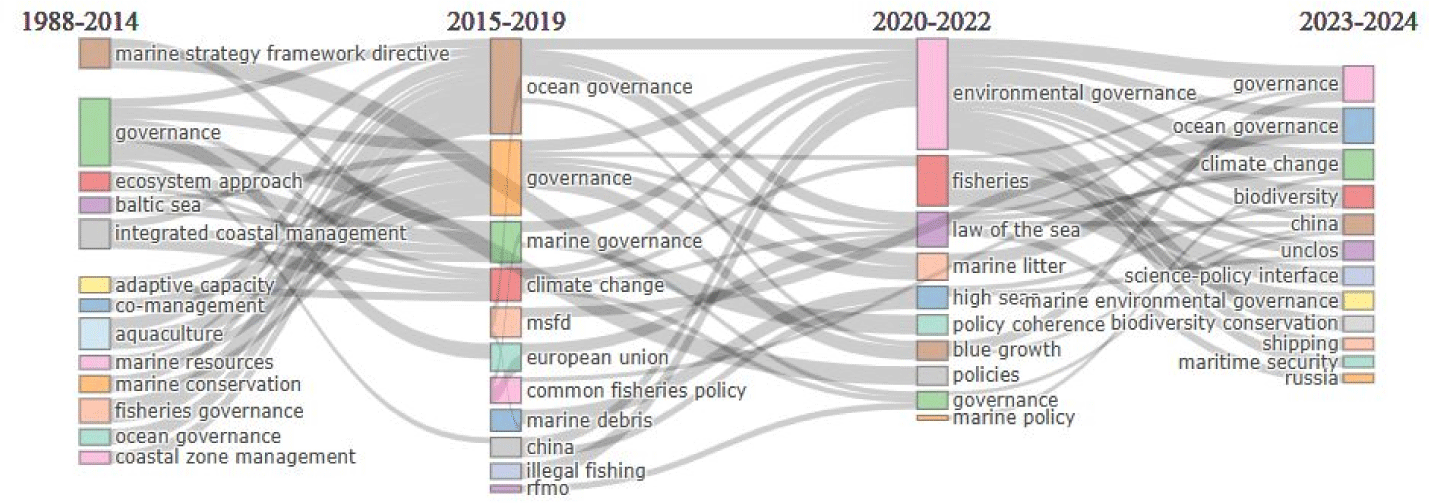
In bibliometric analysis, the factorial approach, especially through word mapping helps in situating the interconnectedness, concentration level, performance, and perception of a given research theme in each field. When more themes are concentrated in each cluster, it signifies a high degree of connectedness and perception in the research field. In Figure 14, multiple correspondence analysis criteria were used to analyze the 50 key themes/words in research on ocean governance and policy. As revealed in the red cluster, there is a recognition of the need for sustainable ocean governance and policy mechanisms, including regulatory frameworks, and fishery management. However, the blue cluster indicates that there are still gaps in identifying and operationalizing integrated ocean governance and policy approaches, such as those involving ecosystem management, oceanography, and public policy.
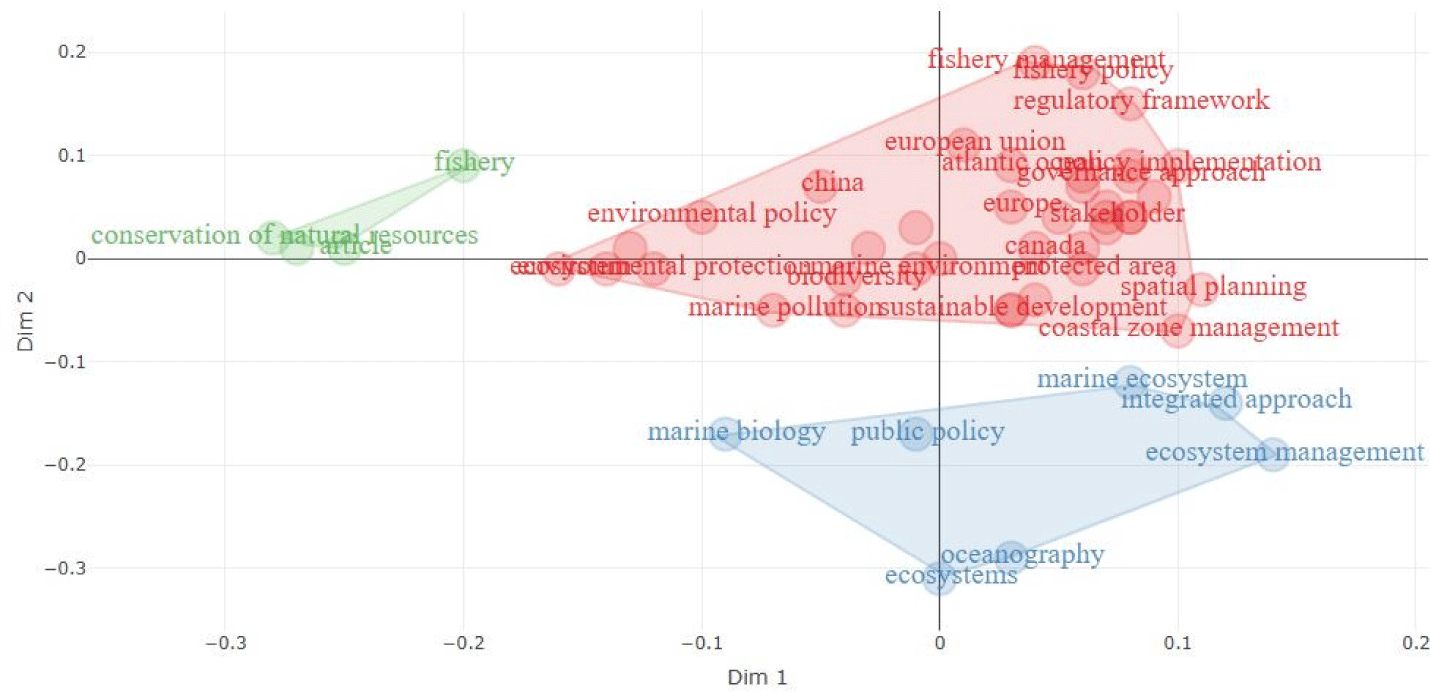
4. Discussion
From the analysis of the literature, notable findings (recurring impediments and opportunities for sustainable ocean governance, and policy), are revealed.
First, on a positive trajectory, there is evidence of increased interest in understanding issues related to ocean governance and policy. This narrative is supported by the increasing scholarship, publication, and citation of works that dive into critical ocean issues, such as marine pollution, fisheries, MPAs, and MSPs. Most of the narratives mirror key recommendations that are targeted to drive ocean sustainability targets and interventions (Cavaleri Gerhardinger et al., 2023; Evans et al., 2023; Matovu et al., 2025). Among the top cited and impactful works, a nexus of ocean governance inhibitors is reported, including tweaks in the implementation of the MSP directive in the EU. To cascade through these challenges, a shift from conservative-centric governance to a more inclusive approach, that factors in the BE perspective and recognizes international agreements, such as the CBD are recommended. These are sweeteners in the drive toward sustainable and collaborative ocean governance measures, such as ocean policy coherence, social equity, and a human-centric approach to the utilization of ocean resources (McDougall et al., 2021; OECD, 2024; Ota et al., 2022). As authors publishing works on key sustainable ocean governance and policy issues have gained traction and repute, more scholarly output in the ocean governance discourse is yielding positive benefits. This is because the sustainability narratives maturated by prominent authors, institutions, and journals align with the global perspectives emphasized on charting holistic ocean governance mechanisms, such as ocean environmental justice, social equity, and environmental governance among others (FAO, 2024a, 2024b; IMO, 2023; IRP, 2021; Lubchenco and Haugan, 2023; Ocean Panel, 2020).
On the other hand, however, amidst the positive aura of sustainability perspectives in ocean policy and governance, blind spots in research and policy have remained prevalent. Jaw-dropping gaps have persisted, such as in leadership of ocean policy and governance direction, scholarship visibility, financing, and collaborations. Notoriously worrisome indicators are evident in the thematic focus on research and how to break the historical north-south, developed-developing countries’ divide in creating balanced ocean governance, policy, and research directions. For instance, there is a divide between global north-south/developed and less developed countries regarding research authorship, collaborations, and leading affiliations in research. This divide is unsurprising and is a direct repercussion of unfair politics (in research, promulgation of laws and policies), that has dominated the ocean governance and policy discourse. The uneven nature of ocean politics has been worsened by the cementing of historical trajectories on who manages and conducts ocean research, has access rights, and determines policies for the global commons, especially on the high seas (Armitage et al., 2017; Blythe et al., 2021a, 2021b). Most often, the winners have been the rich or developed countries that have a competitive advantage in financial, technical, and colonial history over vulnerable coastal states (Matovu and Raimy, 2022; Partelow et al., 2023; Spalding et al., 2023). A study by Spalding et al. (2023) succinctly revealed that the colonial legacies and histories in tropical regions led to a wave of unfair agreements and legislation, such as on fish access and fish value chains, that have led to unfettered overfishing by rich coastal states and distant water fleets from more developed countries.
This uneven trend (in research) could poke more holes in the historically fragile and complex ocean governance and policy landscape, especially on the high seas (IMO, 2023; Lubchenco and Haugan, 2023; Matovu, 2024). Most often, management, research (e.g., marine scientific research), and leadership in the Area have been under the unsustainable and unjust precincts of the powerful coastal states, with dire consequences (IRP, 2021). For instance, it is reported that the increase in ocean gyres has partly been a result of the increased technical delays in the enforcement/promulgation of a comprehensive marine plastic pollution legal framework/regulations (IMO, 2023; Miloslavich et al., 2018). The limited operationalization of marine plastic regulations by the 192 coastal states has led to the release of about 4.8 to 12.7 million metric tons of plastic waste into the ocean (Zhang et al., 2018). The increase in ocean pollution has opened an unsustainable ‘pandora box’ of challenges, including the loss of unique habitats for fish species, and an increase in invasive species (due to ballast water releases) (Bleischwitz et al., 2023; FAO, 2024a, 2024b). Worst-case scenarios of the effects of marine microplastic pollution and marine species ingestion have been reported in the coastal waters of China, which is the leading producer of plastic materials (Zhang et al., 2018).
More concerning governance and policy deficiencies were revealed in the scientific mapping and network analysis of research on ocean governance and policy. For instance, the word and thematic mapping of keywords and themes emphasized in research among global north scholars or leading institutions are discordant to key sustainable ocean development targets, especially in tropical regions. One of the discordant themes that warrants a critical lens of in-depth exploration but has been emphasized in scholarship is MSP. Most scholars and institutions in developed countries have emphasized MSP as the launch pad for sustainable transboundary ocean governance (Ehler, 2021; Maes et al., 2016; van Tatenhove et al., 2017). The emphasis on scaling up MSP (especially after the 2014 MSP directive in the EU), seems to have been blind to the unbridled injustices in ocean policy and governance, in tropical zones (Vince et al., 2015, 2017). Little wonder, recent studies have reported that MSP needs to be treated carefully as it could cement ‘elite capture and dominance’ of marine space by influential stakeholders and powerful coastal states (Ehler, 2021; Matovu et al., 2024e).
The mismatch in key themes emphasized by leading authors/institutions leads to a limited focus on addressing critical drivers of sustainable ocean governance and policy, such as social equity, blue financing, environmental justice, and inclusive/collaborative institutional governance, as emphasized in recent studies (Bennett et al., 2021, 2022, 2023; Croft et al., 2024; Scott et al., 2024). Recent studies have reported that a critical Achilles heel that impedes global ocean governance and policy has been the limited funding and financing of vulnerable coastal states, as governance stewards (Matovu et al., 2024c; Sumaila et al., 2021, 2023). Although policymakers and researchers have feted the need for MPAs, the cost is unsustainable, irrespective of the geography. Estimates reveal that the global cost of managing an MPAs was 2.3 billion USD, and this could have ballooned today (Sumaila et al., 2021, 2023). The unsustainable financial costs of MPA are evident in the Mediterranean Sea region where annual financial deficits of 776.4 million USD are reported (Sumaila et al., 2021). This has implied that for the global coverage of MPAs to increase from the current 2.3% to fully/highly/effectively managed MPAs, an astronomical financial outlay of 7.7 billion USD (unaffordable by most coastal states), is needed (Lubchenco and Haugan, 2023; Sumaila et al., 2021).
Thus, for ocean governance to be sustainable, justifiable, fair, feasible, and equitable financing mechanisms that generate, align, account, and reinvest the accrued financial capital and gains from ocean resources need to be set up (Sumaila et al., 2023). However, much often, tropical biodiversity-rich coastal states have hardly reaped from this. Vulnerable coastal states are increasingly becoming ecological debtors rather than creditors (IRP, 2021; OECD, 2024; Sumaila et al., 2021). This is partly due to the historical focus on economic-centric governance and policy frameworks/models in harnessing marine resources, such as fish, and most recently, deep-sea minerals (FAO, 2024a, 2024b; Matovu, 2024). Such models focused on squeezing out a monetary value from marine ecosystems and resources, such as fish (Lubchenco and Haugan, 2023). This compromises the ecosystem integrity of marine natural capital resources/assets, as highlighted in the Millennium Ecosystem Assessment (Sumaila et al., 2023). In worst-case scenarios, the fear by key/influential stakeholders of losing their historical concessions, in tropical seas, had led to the limited emphasis on/ratification of global ocean governance regulations, such as those embedded under the UNCLOS (Chang, 2023; Haas et al., 2021; Jouffray et al., 2020, 2023; Matovu, 2024; Matovu and Raimy, 2022).
The financial fragility of vulnerable coastal states, such as SIDS has made them succumb to the temptations of accepting reactionary and short-term institutional and socioeconomically unjust policies (Matovu, 2024; Matovu and Raimy, 2022). For instance, in most tropical SIDS, rich or developed countries, private monopolies and companies have influenced the signing/promulgation of unsustainable fishing agreements (FAO, 2024a). Such agreements have not only compromised the ecosystem balance but also buttressed access rights to fishing zones of most small-scale fishers and Indigenous communities (FAO, 2024a; Matovu, 2024). Such unpalatable governance and policy mechanisms have ruined trust in collaborative governance mechanisms and created bleak sustainable livelihood futures (Partelow et al., 2023; Spalding et al., 2023). In worst-case scenarios, as the socioecological systems are increasingly being threatened, a new wave of contested marine user conflicts has steeped, regarding the responsibility of sharing the burdens, costs, and benefits of ocean commons/resources (Armitage et al., 2017; Blythe et al., 2021b; Gupta et al., 2024; IRP, 2021). A nexus of these complexities has unplugged divergent and mostly parallel perspectives on reassembling fair ocean governance and policy measures (IRP, 2021; Paterson and Chabay, 2024; Stefanoudis et al., 2023; van Leeuwen et al., 2024). This is irre-spective of the recognition of the ocean as a shared resource, a unique global common, that must be jealously guarded if sustainable futures are to be attained for all (Fuso Nerini et al., 2024; Gupta et al., 2024; Haward, 2015; Raakjaer et al., 2014; Sachs, Lafortune, and Fuller, 2024; Voyer et al., 2021).
5. Crafting a Sustainable Ocean Governance and Policy Future
In section 4, it is revealed that although some mechanisms to promote ocean governance and policy are emphasized, gaps are prevalent, and this might inhibit the operationalization of sustainable ocean futures. As the creation of transformational pathways for ocean sustainability is an urgent necessity, we contribute to this by identifying five sustainable Ocean futures and collaborative governance leverage points: (i) socio-cultural, (ii) economic, (iii) institutional, (iv) environmental, and (v) technological. To identify the leverage points, we painstakingly reviewed the literature to (i) identify perpetual inhibitors to ocean governance and policy and (ii) explore insights emphasized to drive sustainability transformations, and sustainable ocean futures. To add scholarly relevance, for each leverage point, practical examples are given that show the feasibility of a leverage point in breaking impediments to collaborative ocean governance and policy formulation, ratification, implementation, and operationalization across coastal states and the ocean. The next paragraphs explicitly give interesting perspectives on this.
Studies have categorically indicated that a historical impediment to the charting of inclusive ocean governance mechanisms has been the unfathomable exclusion of vulnerable social groups, such as Indigenous coastal communities, coastal women, and vulnerable states in the policymaking discourse (Matovu and Raimy, 2022; Matovu et al., 2024e; Partelow et al., 2023; Spalding et al., 2023). Exclusion has been prominently featured in lucrative long-established ocean sectors, such as fishing, marine transport, mining, and tourism (IMO, 2023; Lubchenco and Haugan, 2023; Matovu et al., 2024b, 2025). In the fisheries sector for instance, although women have been the drivers of fisheries value chains, over 80 percent are engaged in vulnerable employment and few policies have been enacted to boost their empowerment (FAO, 2024a, 2024b). Worst-case scenarios have been reported among vulnerable Indigenous communities sedentary in resource-rich ocean zones, such as in the Pacific Ocean (Vince et al., 2015, 2017). Here, the historical rights of these communities have been usurped, and yet, before the ratification of the High Seas Treaty, few policies were considerate of the needs of indigenous communities (Matovu, 2024; Matovu and Raimy, 2022). The social injustices have created a dichotomy of unsustainable governance challenges including resentment of micro-level governance frameworks, mistrust, structural injustice, disempowerment, voluntary practices on co-management, and loss of critical social science citizens’ knowledge on the management of unique marine species (Bennett et al., 2022, 2023; Croft et al., 2024; Scott et al., 2024).
The recognition of the contribution of coastal communities in the ocean sustainability discourse has been primed to unplug critical social tipping points for sustainable governance (Matovu et al., 2024e; Spalding et al., 2023; Scott et al., 2024). By creating social leverage points, five sustainable social science priorities to guide ocean governance, policy, and initiatives can be hatched. These include the promotion of ethical and moral facades in policy decision-making, improved co-governance (including voluntary management of coastal zones and resources), morality in addressing the systemic impacts of ocean activities on coastal communities, creation of moral or acceptable values, and codes of an-thropogenic behavior in the utilization of ocean resources and collaborative co-creation of transdisciplinary partnerships/governance pathways (Matovu et al., 2024a; Spalding et al., 2023). Using the transdisciplinary approach to co-design sustainability pathways and narratives drives micro-level co-governance and inclusion in coastal fisheries value chains (Matovu et al., 2024e). Such narratives might be critical in debunking historical disempowerment blocks that have boxed out most tropical fisheries communities/countries from the policymaking table on most global fisheries agreements (FAO, 2024a; Spalding et al., 2023).
Today, it is common knowledge that ocean governance has been complicated by the sporadic negative oscillations in ocean environmental patterns (IRP, 2021). For instance, climate change-induced impacts, such as sea level rise have led to shifting baselines, loss of sovereign rights of SIDS, and fear of disappearance of SIDS, among others (Matovu and Raimy, 2022). Such environmental concerns have naturally made provisions embedded under the UNCLOS, such as on governance of migratory species, determination of baselines, and outer limits of the continental shelf, among others, utterly less applicable (Matovu, 2024; Matovu and Raimy, 2022). A worse scenario was envisioned as limited regulatory safeguards were in place, for instance, to protect high-seas biodiversity and the destiny of submerging islands, before the ratification of the high-seas treaty (Matovu, 2024; Tafon et al., 2022). With the ratification of the high-seas treaty, avenues for collaborative governance and policymaking could be charted, such as the creation of a regulatory mechanism for ocean gyres, transboundary ocean mining, and marine plastic pollution (Haward, 2015; Miloslavich et al., 2018; Zhang et al., 2018).
What remains to be seen, however, is how to operationalize such collaborative governance mechanisms. Recent studies have highlighted four focal and coherent areas/phases that can guide this, including transformative intention, collaborative designing of sustainability policies, collaborative implementation, and collaborative evaluations (Partelow et al., 2023; Spalding et al., 2023). Such a phased approach can help improve socio-economic-environmental benefits and minimize harm. For instance, the Natural Resources Governance Institute has identified seven key perceptions on how such a sustainable governance mechanism can be created, to minimize the hidden and overt coasts of offshore and coastal mining (Jouffray et al., 2023; Matovu et al., 2024c). This proves that the early integration of inclusive governance perspectives during intention setting, and design phases offers the deepest potential for delivering sustainability benefits and reducing risks across the human-environmental landscape (Bennett et al., 2021, 2022, 2023; Croft et al., 2024). Later-stage collaborations can leverage opportunities in existing projects to reflect and learn while improving impact assessments, transparency, and reporting for future activities (Cisneros-Montemayor et al., 2019, 2022).
These relate to the creation of sustainable win-win, equitable, and sustainable economic benefit-sharing policies/governance mechanisms on/for ocean resources, goods, and services. A critical concern in ocean governance/policy has been the apportionment of fairness in who gains and losses from the tapping of ocean goods, services, and resources (IRP, 2021). This has been well-documented in the heated contestations among rich and emerging countries on financing or creation of carbon-offsetting policies and climate-change resilience pathways (Blythe et al., 2021a, 2021b; Sumaila et al., 2021, 2023). Additionally, in the ocean policy and research arena, although serious studies have been conducted on value estimation of resources and factors affecting value, which are very important for the global economy, few studies examine the effect of economic vulnerabilities and unfair economic injustices on tropical coastal countries, and attitudes towards the ocean economic landscape (Lubchenco and Haugan, 2023; Sumaila et al., 2023). Therefore, there is a need for an integrated and sustainable economic model that can both predict the current and future sustainability funding/economic valuations, based on the data obtained from different stakeholders (Ocean Panel, 2020; OECD, 2023, 2024).
Recent studies have proposed a deviation from the unjust traditional ocean financing models, including traditional loans, and foreign direct investments from rich coastal countries to poor countries (in substitute for concessions) to blended financial pathways (Sumaila et al., 2021). Such novel financial governance pathways can birth a typology of benefits, especially in the context of depleting ocean resources: (i) recognition of the depletion of re-source stocks, (ii) scientific/economic/financial sustainability knowledge of ecology and resilience of targeted species and their role in ecosystem dynamics, and (iii) demonstration-scale experimental trials, building on smaller-scale sustainability financing experiments (Croft et al., 2024; OECD, 2024; Sumaila, et al., 2023). This can help bid farewell to unsustainable business models, that have created a discernible gap in the financial risk-return equations of the ocean economy landscape (IRP, 2021). The creation of sustainable ocean financing pathways, including a sustainable financing mechanism (as envisioned in the High Sea Treaty), breeds new competitive market returns (led by vulnerable but resource-rich coastal states) (Sumaila et al., 2021, 2023).
This leverage point mirrors the developed blue ocean financing models/approaches, such as the Blue Finance Commitment ‘backblue initiative’ that was launched in 2021 before the Conference of Parties (COP26) (ORRAA, 2024). Through the #backblue’ initiative, global commitments towards the United Nations (UN) ‘Race to Zero’ financial initiatives are being created. These have involved the setting up and adopting of science-based targets to reach net zero no later than 2050 (Sumaila et al., 2023). This commitment has been spiced up by the setting up of the Net Zero Asset Owner Alliance target-setting protocol, with transparent investment pathways for a sustainable BE (ORRAA, 2024). Such initiatives have been reinforced by the UN Race to Zero Financial Initiatives and by adopting science-based targets to reach Net Zero no later than 2050 in line with their criteria. This includes aligning investments with the UN-convened Net Zero Asset Owner Alliance’s target-setting protocol. This has led to the creation of new ocean protection due diligence requirements, guided by international frameworks, such as the Sustainable Blue Economy Finance Principles hosted by the United Nations Environment Programme Finance Initiative (UNEP FI) and the Environment and Social Policy Framework (Deutsche Bank, 2024). These are sound leverage points formally aligned with internationally recognized standards and principles, such as the Ten Principles of the UN Global Compact, the OECD Guidelines for Multinational Enterprises, and the UN Guiding Principles on Business and Human Rights (Deutsche Bank, 2024; OECD, 2024).
These focus on ameliorating past injustices in ocean governance and policy decision-making, leadership, and implementation. The powers and influence of historical ocean treaties and institutions have been for a long time vested in the hands of the powerful and rich coastal states; with dire implications (Matovu and Raimy, 2022). A prominent ramification is evident in how the powerful coastal states bullied the fair regulatory mechanisms and principles promulgated by the proponents of the UNCLOS (Chang, 2023; Haward, 2015). The complex institutionalized politics on ocean commons is further reported with the complacency demonstrated by developed countries in bringing onboard perspectives and decisions of less developed countries, such as on conducting marine scientific research and ocean mining in the high seas, policy instruments on transboundary fishing practices and value chain (Armitage et al., 2017; Blythe et al., 2021a; FAO, 2024a, 2024b; Jouffray et al., 2020, 2023; Matovu, 2024; Matovu and Raimy, 2022).
The recent ratification of the high-seas treaty, which includes critically important and just institutional mechanisms could be key in creating sustainable governance and policymaking (Matovu, 2024). The high-seas treaty, for instance, has advocated for the creation of an access and benefit-sharing Committee (Matovu, 2024). This ensures fair representation and guidance on future monetary benefit sharing. Additionally, a key establishing high-seas treaty institution- the COP is targeted (Matovu, 2024). As a primary decision-making body (onto which equal representation of coastal states/stakeholders is targeted), with the legal authority and backing to adapt to emergency and pressing ocean governance and legal issues, expeditious redress of the concerns of the most vulnerable communities or coastal states will be achieved. Other institutional safeguards being developed, such as under the Ocean Decade are entangled with the premise of promoting just institutional mechanisms that benefit all coastal communities, and vulnerable coastal states (Blythe et al., 2021a, 2021b). Through these mechanisms, critical leverage points that avail a platform for convening different actors are streamlined (IRP, 2021). These institutional and regulatory mechanisms will enchant different actors to create a more nuanced, coordinated, and coherent approach to the conservation and management of the ocean through a cross-sectoral, cumulative impact perspective (Lubchenco and Haugan, 2023). These mechanisms, coupled with improved transparency, will help give the international community a greater say in what goes on in these global commons and will increase its ability to contribute to our knowledge of the ocean environment and the human activities across the ocean and coasts, such as ocean pollution (Armitage et al., 2017; Dauvergne, 2018; Evans et al., 2023; Gupta et al., 2024).
Studies have revealed that sustainable technologies and marine scientific research are primed to be prominent drivers for ocean sustainability, governance, and policy development (Fuso Nerini et al., 2024; Sumaila et al., 2021, 2023). Yet, only about 20 percent of the ocean has been explored or known (IRP, 2021; Matovu, 2024). Additionally, the advances in marine scientific or technological research are uneven; and dominated by rich states (Partelow et al., 2023; Sumaila et al., 2023). These stumbling blocks curtail avenues for the attainment of sustainable ocean development pillars (scientific) and the Ocean Decade targets, such as empowering women in ocean science (IRP, 2021; Matovu et al., 2024b, 2025). This poses current and future risks, such as in mitigating threats from the changing ocean environmental parameters and building the resilience of the increasingly vulnerable coastal communities, such as fishers (FAO, 2024a, 2024b; Sumaila et al., 2021).
To attain just technological transitions, sector-specific policy and governance mechanisms are increasingly being charted. For instance, in the fisheries sector, sustainability transitions have been succinctly documented under the 2021–2030 blue transformation roadmap (FAO, 2024; Matovu et al., 2024e). Under the roadmap, innovative targets, such as technological and digital transformations in the value chains (including monitoring of distant fishing fleets on the high sea), are targeted (FAO, 2024). The scientific and technological leverage points have been cemented by the creation of regulatory safety nets, such as The Right to Food Guidelines and the Small-Scale Fisheries (SSF) Guidelines (FAO, 2024a). This can be supplemented using assessments and indexes, such as the Women’s Empowerment in Fisheries and Aquaculture Index (WEFI) to track the progress made toward building transformative cultures, spaces, and avenues for sustainability (McDougall et al., 2021). The WEFI has qualitative and quantitative indicators that can help determine the level of socio-economic, institutional, technological, and psychological empowerment of a targeted coastal community, based on different dimensions.
Additionally, as most SSFs, especially in the tropics have been disempowered and manipulated, the guidelines are primed to among others: (i) provide guidance to states in their implementation of the right to food over 19 different policy areas with an emphasis on participation, including access and sustainable management of natural resources, (ii) cement efforts towards achieving the SDGs, especially SDG 1 “Zero Poverty”, SDG 2 “Zero Hunger” and SDG 14 “Life Below Water’’ and expands Right to Food Guideline 8 on “access to resources and assets”, while building on the premises of Guidelines 2, 3, 9, 10, 11, and 13 (FAO, 2024a, 2024b; Sachs et al., 2024; Spalding et al., 2023). Related technological and scientific instruments/pathways have been incrementally advanced in other BE sectors, such as marine transport, mining, and ocean energy, such as the common international classification of ecosystem services (CICES), ecosystem-based management assessments, and natural resources stocktakes, among others (Farmery et al., 2021; Haas et al., 2021; IMO, 2023; Jouffray et al., 2020, 2023; Maes et al., 2016). Under the provisions of the high-seas treaty, digitalized versions (i.e., Digital Sequence Information, derivatives, and area-based scientific management tools) for marine genetic and biotic resources are envisioned (Matovu, 2024).
6. Conclusion
This study explicitly highlights the urgency for compartmentalizing and operationalizing sustainable, inclusive, and collaborative ocean governance and policy mechanisms. To cement this and create sustainable futures, a robust focus on ocean sustainability pillars is critical. According to the 2020 Ocean Panel report, the transitions towards sustainable ocean futures will require the creation of governance/policy safeguards, across the socio-cultural, technological/scientific, institutional, environmental, and economic/financial pillars. Unfortunately, the analysis of the literature underscored that this might be a stratospheric undertaking unless urgent efforts are vested toward collaborative governance/policy mechanisms; that are all-inclusive.
Several indicators in literature augment this narrative. For instance, research scholarship is predominantly led or guided or influenced either by researchers or institutions from the global north or developed countries. This might not have been a problem per se, but the thematic focus and key dimensions emphasized by these researchers/institutions hardly exfoliate the core governance and policy needs of most vulnerable communities and coastal states. For instance, an analysis of the trending topics and themes reveals that most authors focus on regional seas, such as the Mediterranean, or regional governance concerns, such as MPAs and MSPs. Recent evidence on some of these topics, such as MSPs have proved that with the financial and historical vulnerability of most coastal states, these might not be the most priority governance mechanisms to drive inclusive governance and livelihood sustainability. The blind preference for researching/disseminating research output that focuses on the needs of the global north or developed states is well visualized in the tree map. Inhibitors for sustainable ocean governance and policy in the global south, such as ocean governance, complexity among small-scale fisheries, coastal communities, and stakeholders’ participation in policymaking have gained less interest and traction.
The social and intellectual structuring of knowledge on ocean policy and governance leaves a lot to be desired. For instance, dominant authors have mostly focused on collaborating with authors from the same institutes, countries, or research field(s). A similar trajectory is evidenced in the country-level collaborations. Developed countries have mostly collaborated amongst themselves in conducting ocean governance and policy research. This complex nexus has bubbled a duopoly of unsustainable governance concerns. First, social science narratives of vulnerable and indigenous communities on co-governance, and equity transitions in policymaking, formulation, and implementation are often missed. The limited focus on marine social science governance perspectives or interventions is well-documented in recent studies. Only 16 percent of marine social science research has been conducted. Second, this limits just transitions and acknowledgment of the historical risks created by some unsustainable Western-centric Ocean resource management and utilization approaches. Yet, history has proved that some of the economic-centered approaches used, such as in capture fisheries are partly to blame for the mistrust in global fish-value chains/markets and operationalization of commendable fisheries treaties and agreements, such as the 1995 Fish Stocks Agreement.
Nevertheless, irrespective of the current concerns and gaps in ocean policy and governance, emerging threads of possibilities were revealed. More journals are encouraging novel research that gives new perspectives on inclusive ocean governance. Additionally, the realization of the need for collaborative management of the increasingly plummeting ocean resources has birthed new paradigms for ocean governance, such as the BE. This has created a once-in-a-lifetime opportunity to situate concerns of vulnerable countries into the global ocean governance and policy discourse. This positive fervor is supported by the increasing ratification of integrated ocean governance regulatory mechanisms, such as the High Seas Treaty. To contribute to this increasingly promising paradigm shift, we intricately synthesized literature and identified five sustainable Ocean futures and collaborative governance leverage points: sociocultural, economic, institutional, environmental, and technological. As the leverage points are situated within the realm of ocean sustainability pillars, they could be the missing link between breaking past failures to charting sustainable futures in ocean policy and governance.
The strong conviction on the feasibility of the developed leverage points is because most studies and policy mechanisms are comprehensively envisioning perspectives on equity, inclusivity, collaboration, and co-creation of transformative governance mechanisms. And since ocean governance-related issues will always be an ever-present discussion not just in maritime research and policy but also in the global sustainable development agenda, the identification of key leverage points could help in the creation of micro-level governance pathways. Since ocean governance and policy have been a complex undertaking, sustainable ocean governance, and policy futures would necessitate (i) the acknowledgment of past injustices and histories that created unsustainable ocean indicators, (ii) the recognition of the role vulnerable coastal communities and less developed coastal states can play in building sustainable ocean transitions, (iii) respect for diverse governance and policy perspectives and narratives, and (iv) breaking of insatiable powers/influence/interests of historically dominant coastal states (that have either mostly crippled the ratification and operationalizing of ocean governance and policy regulatory mechanisms, such as the UNCLOS or bulldozed vulnerable/less developed coastal states to accept unpalatable/unfair ocean governance mechanisms/regulations/principles).








